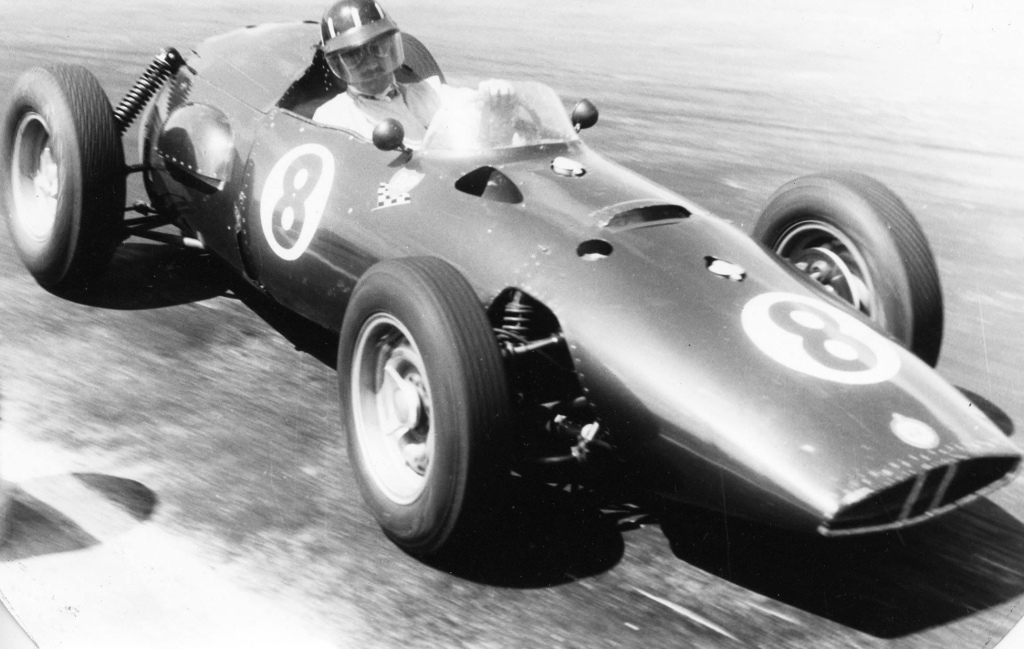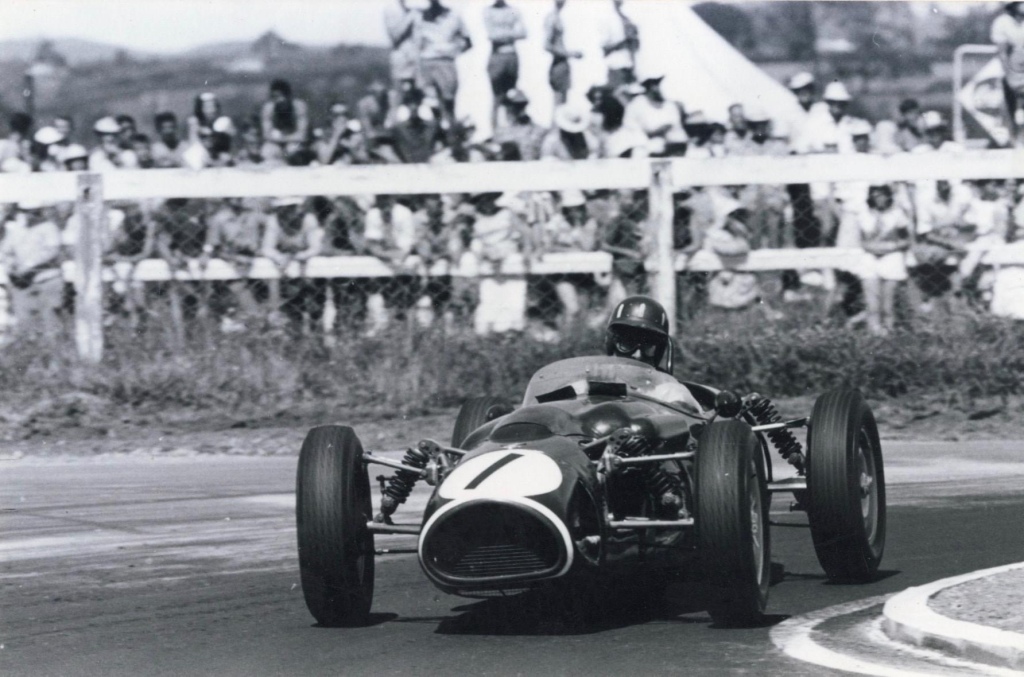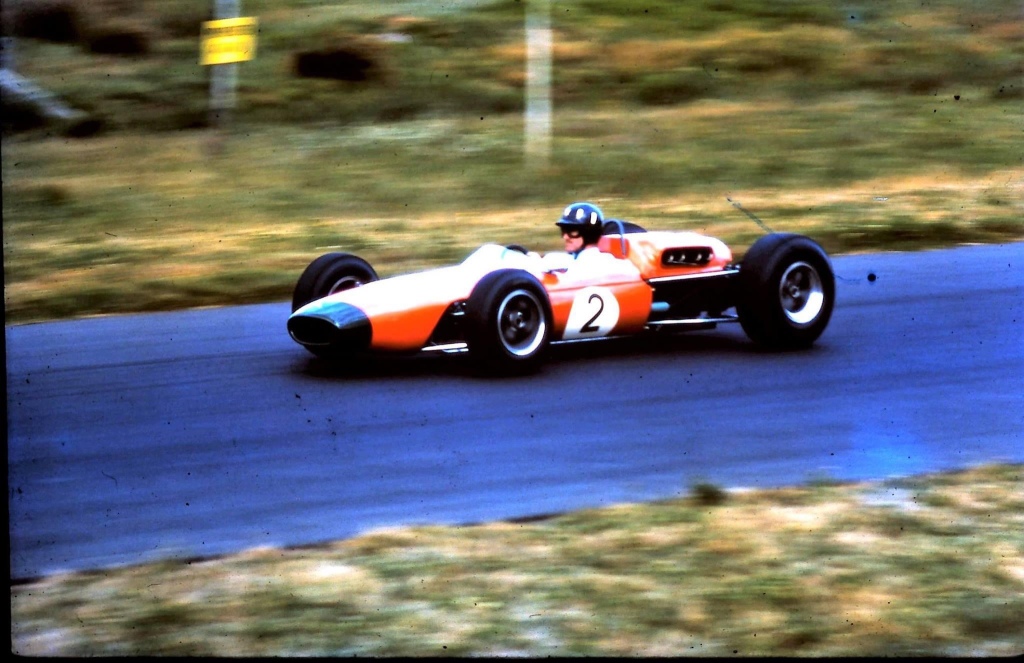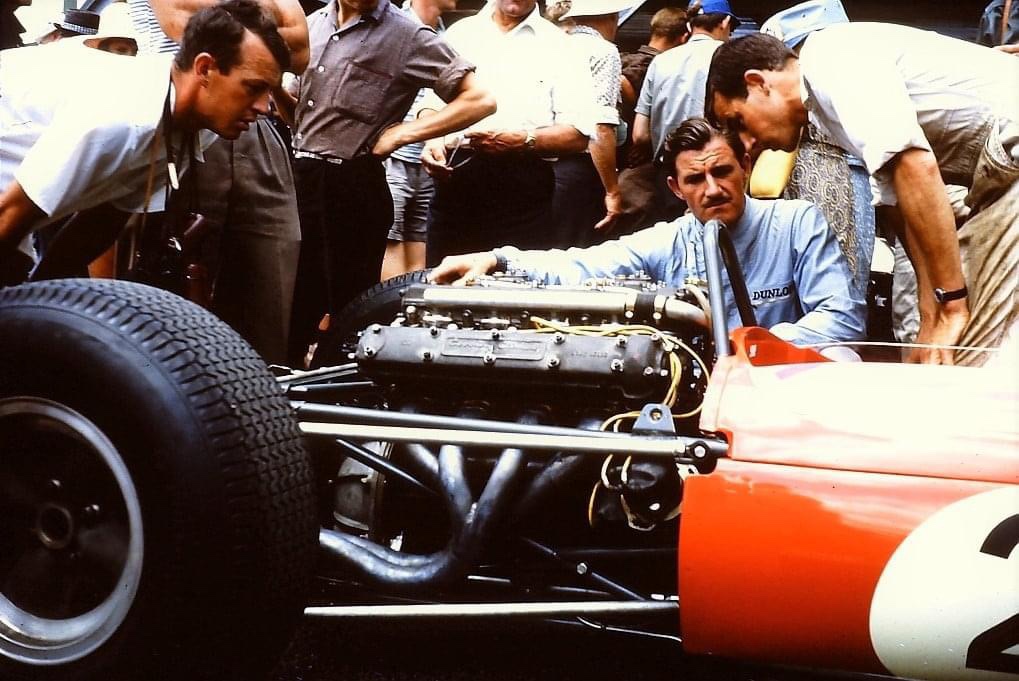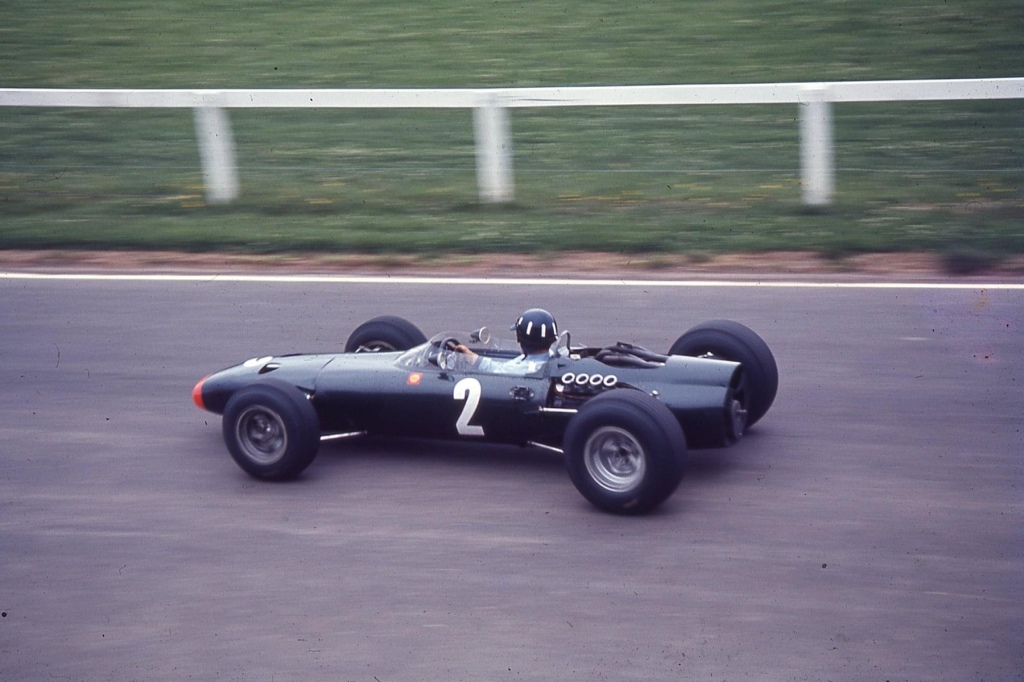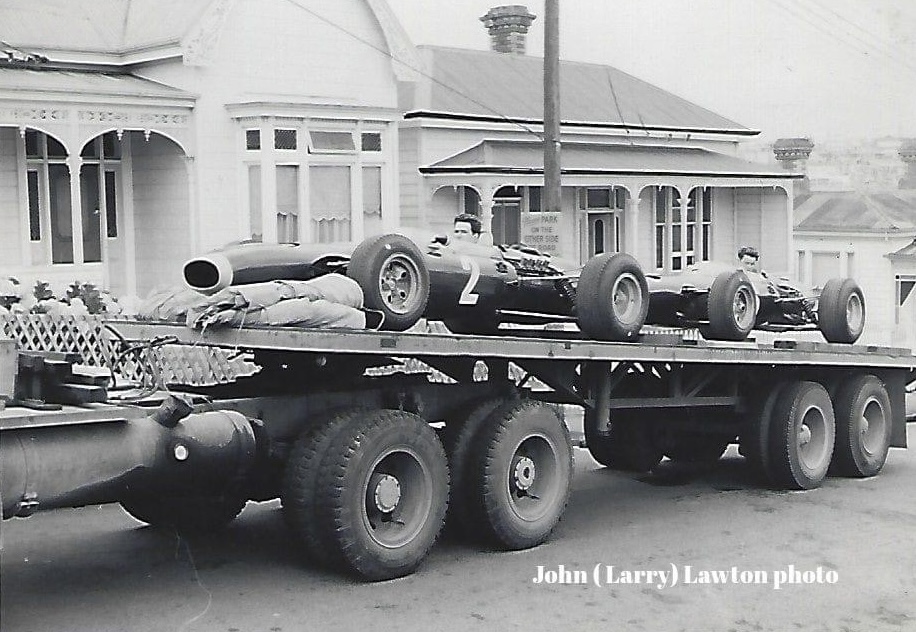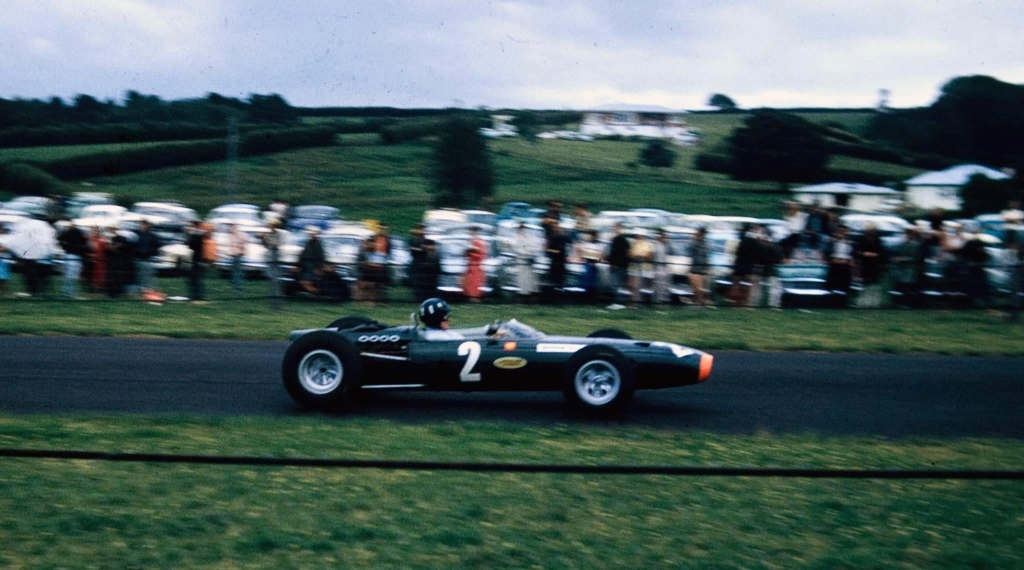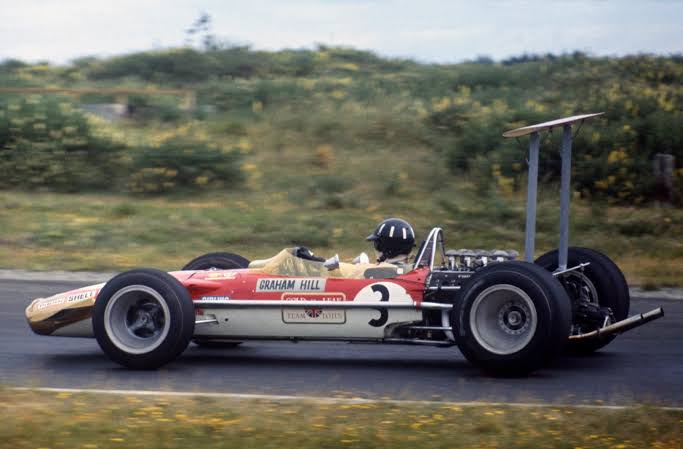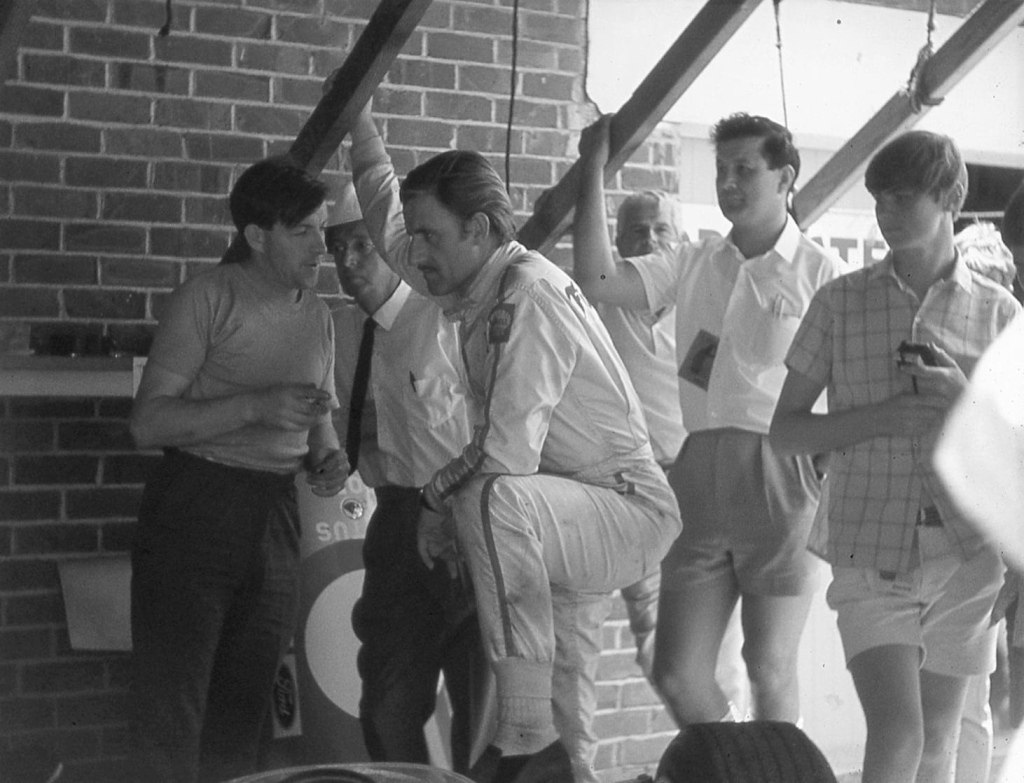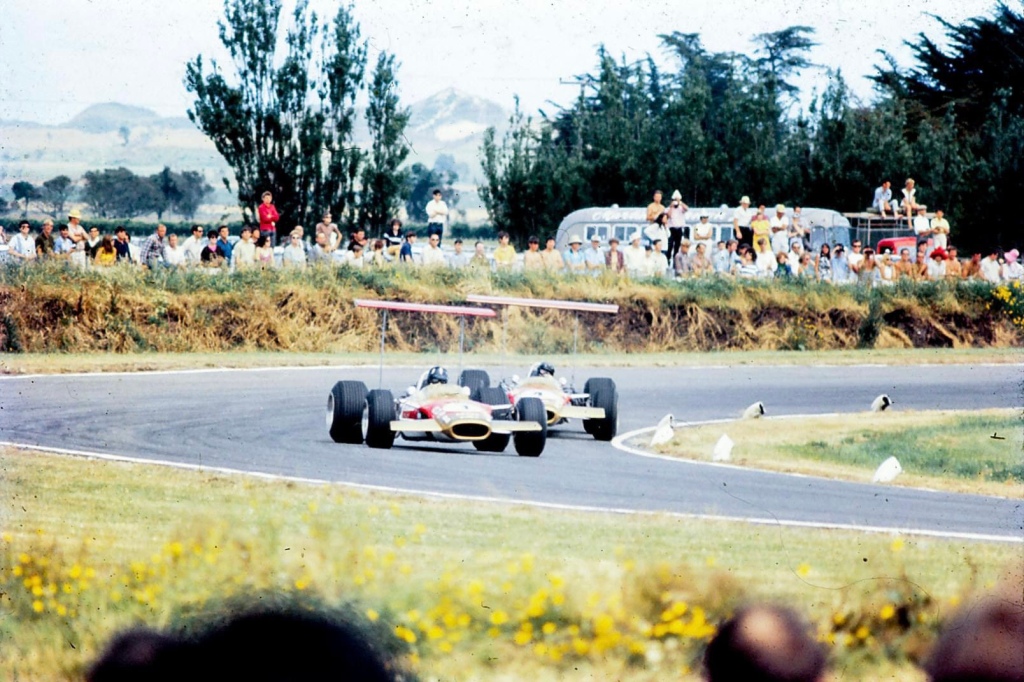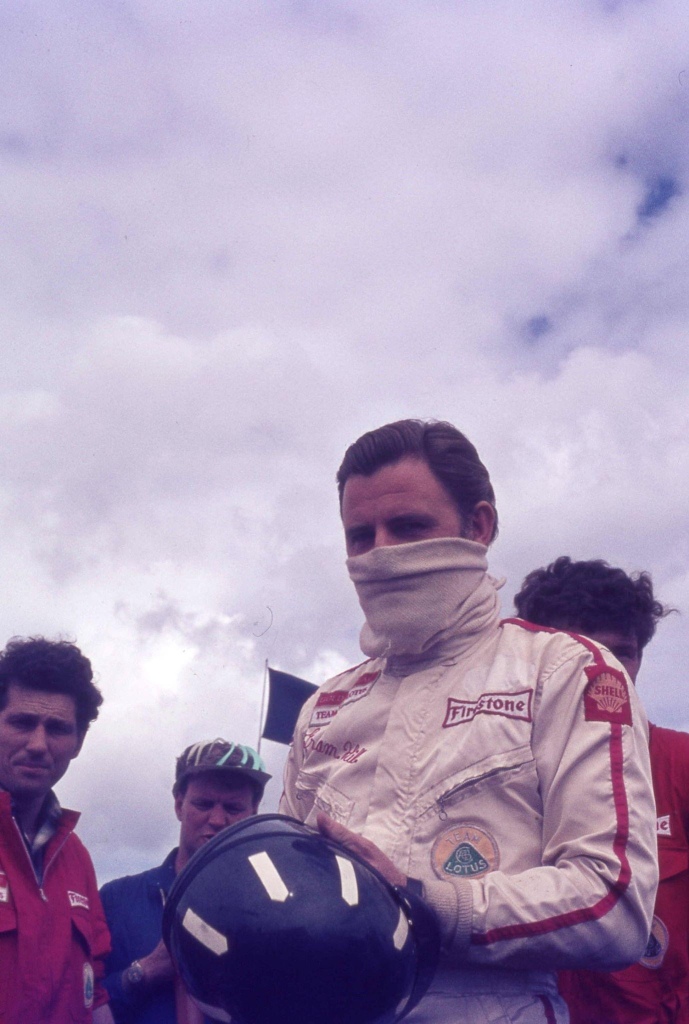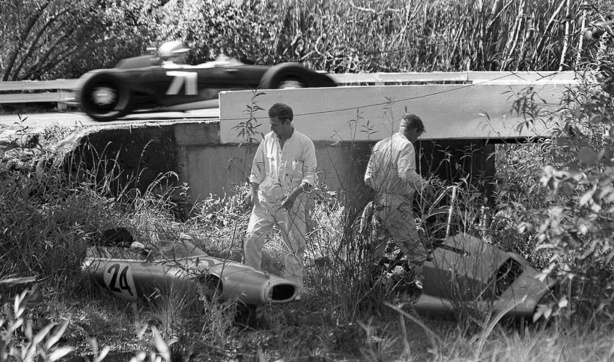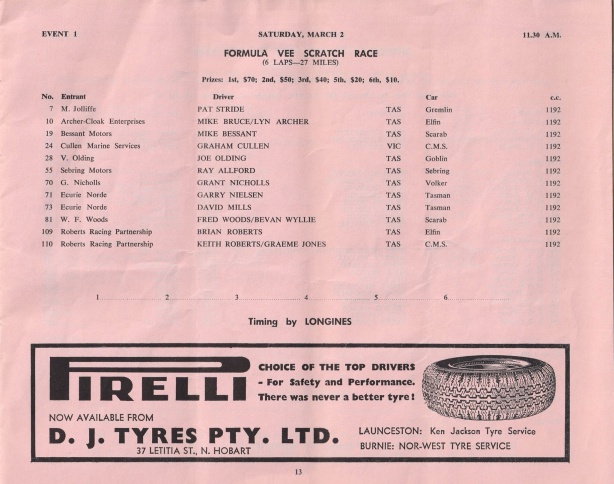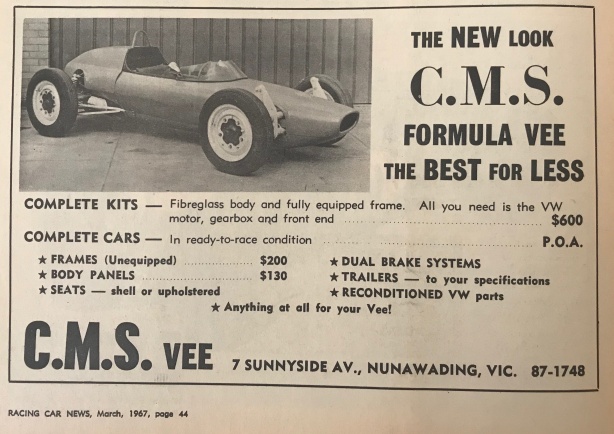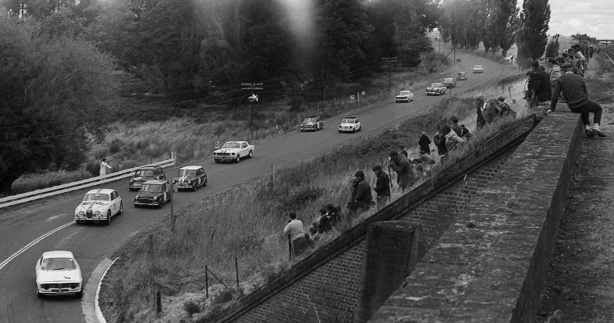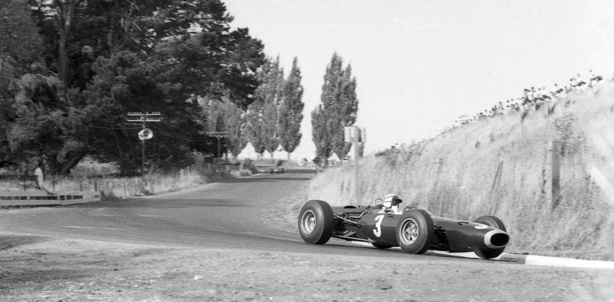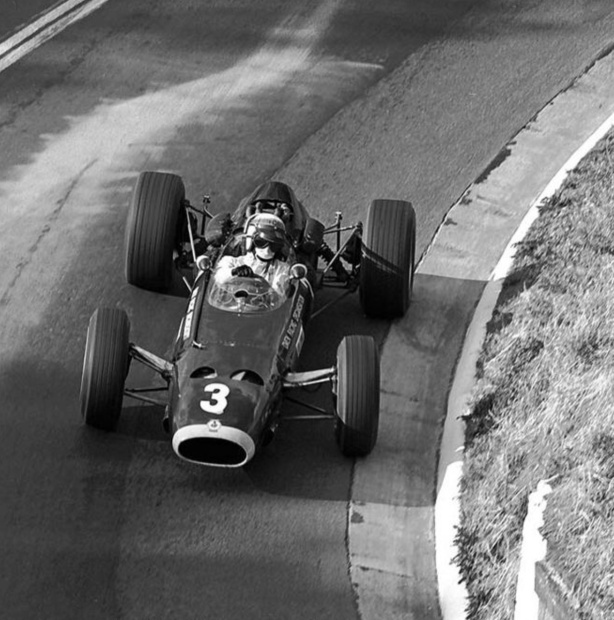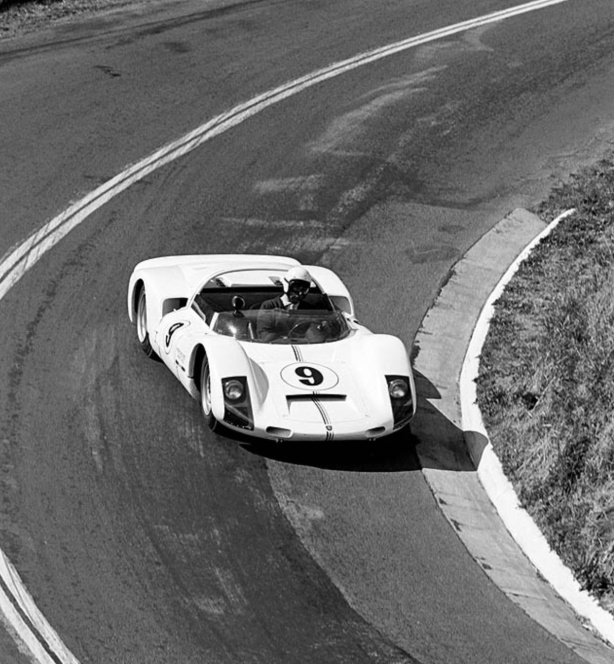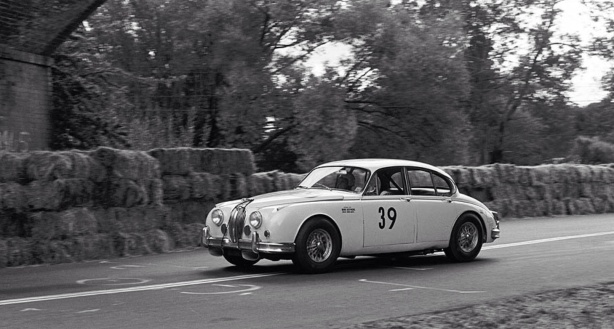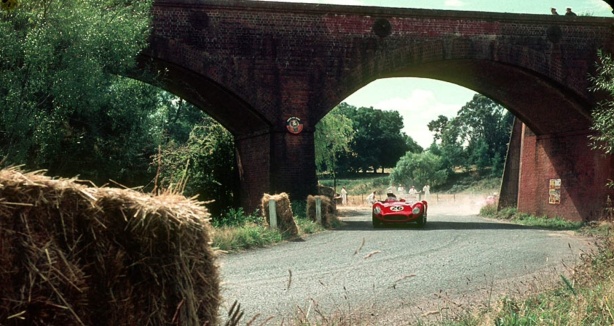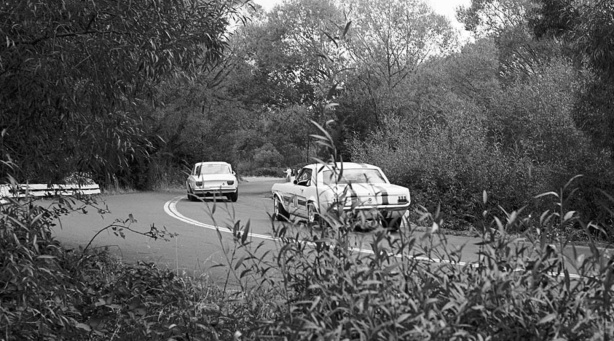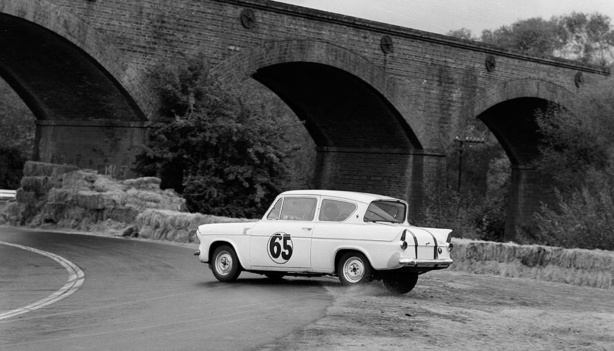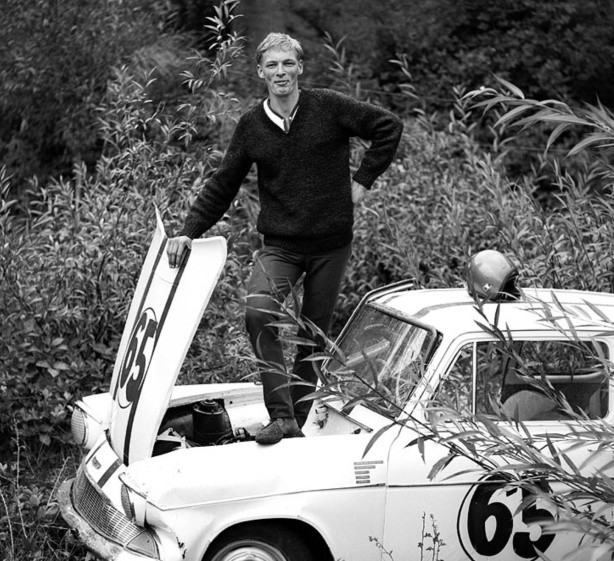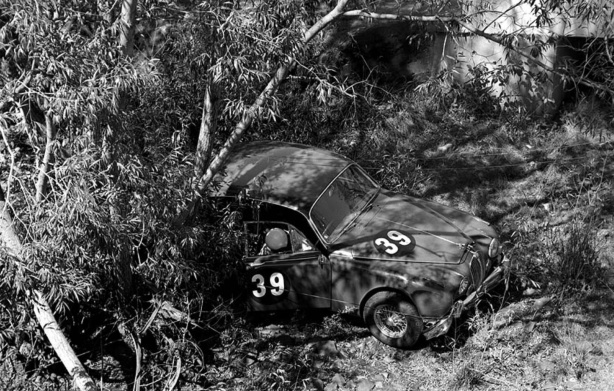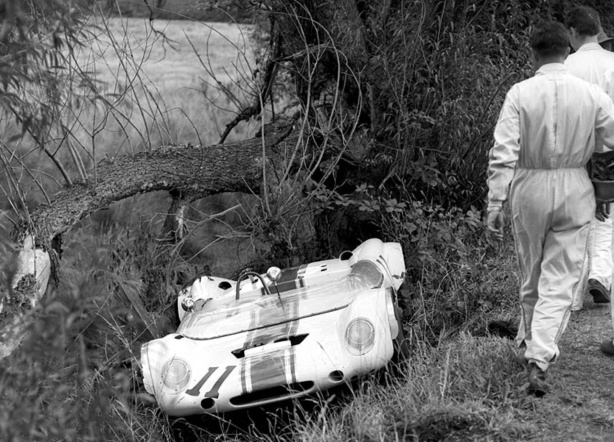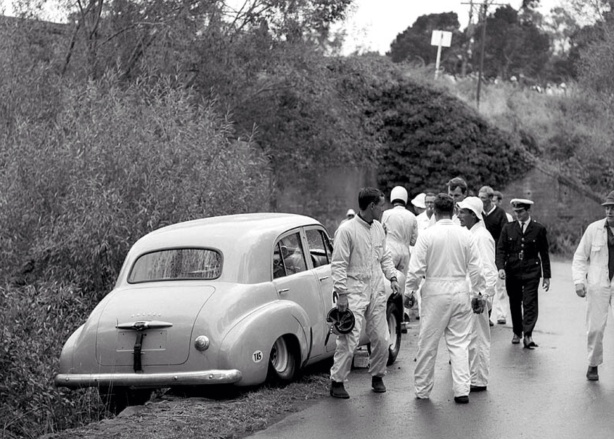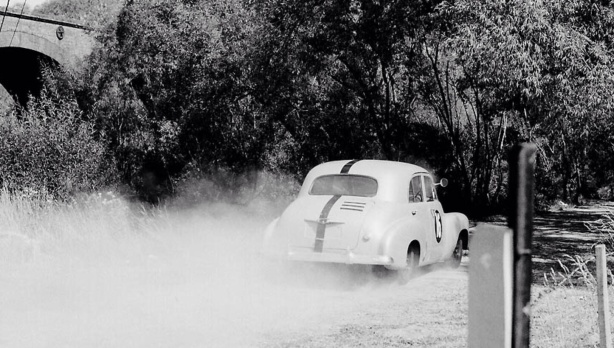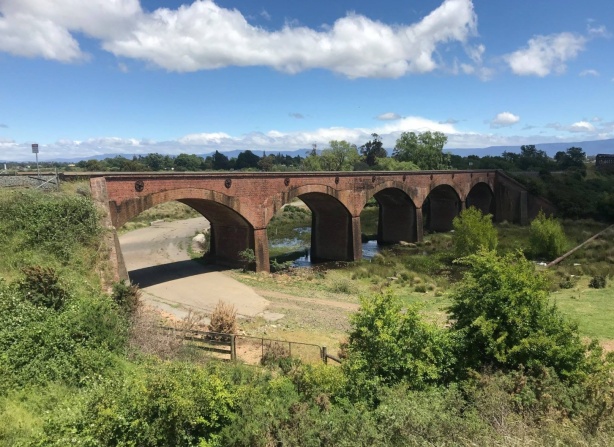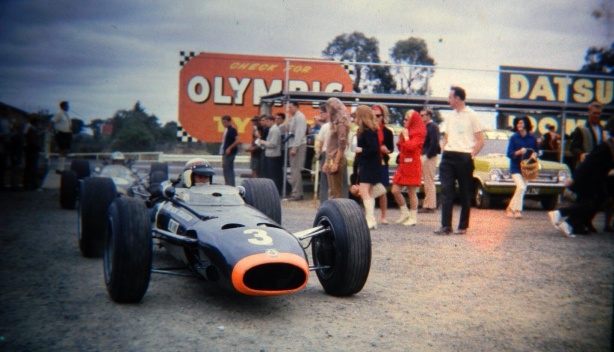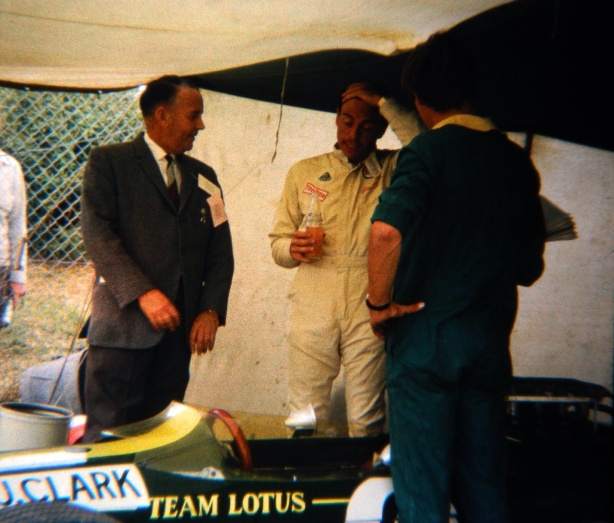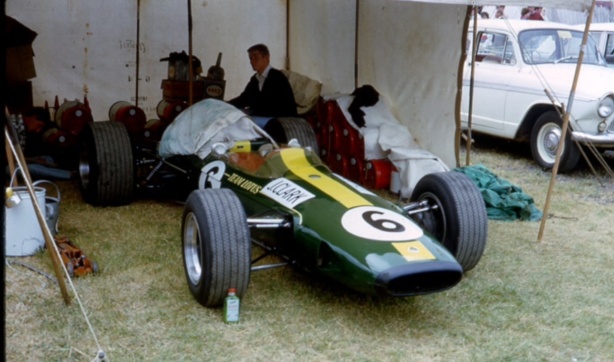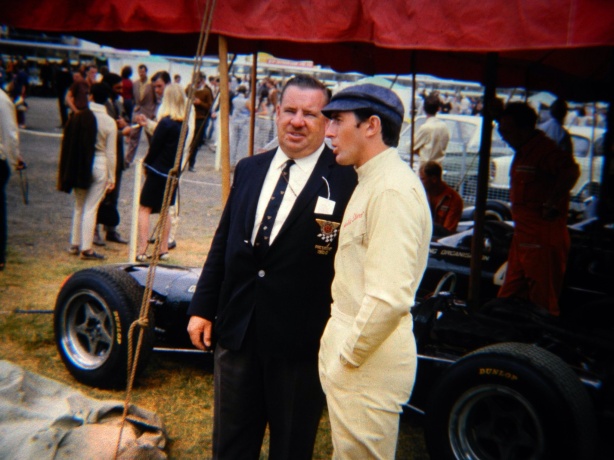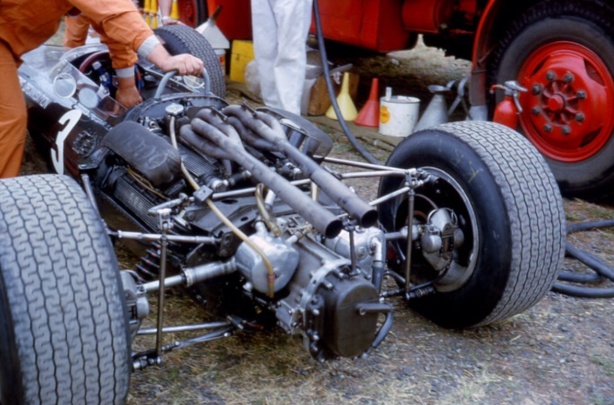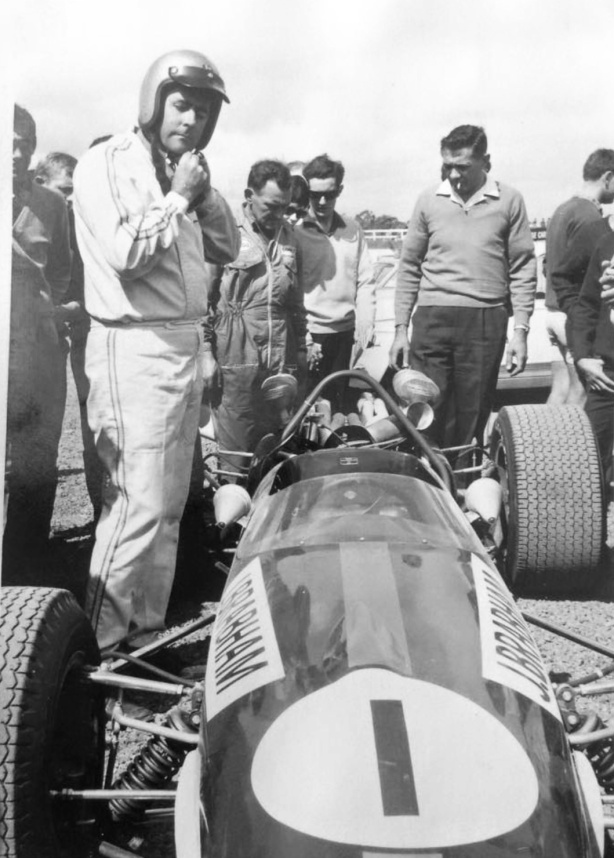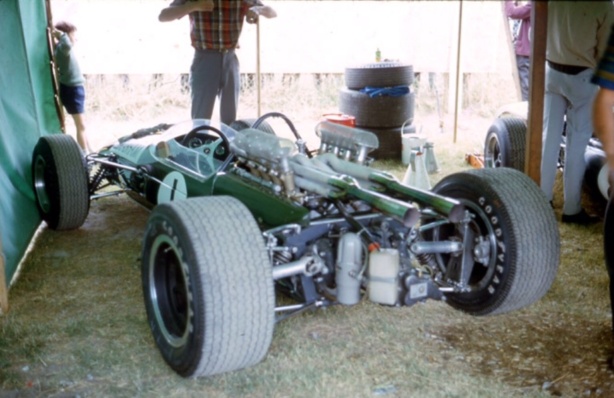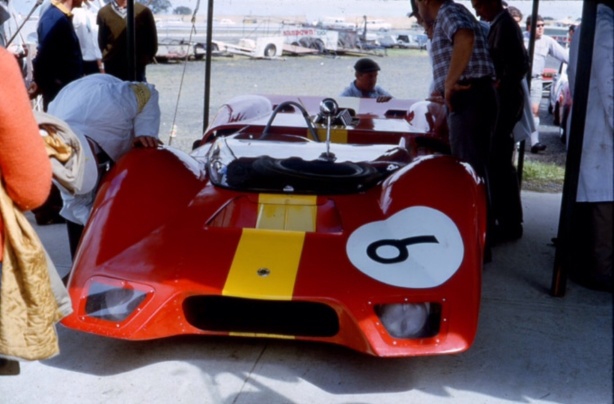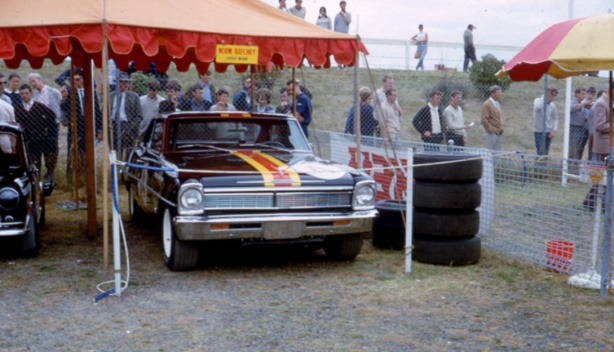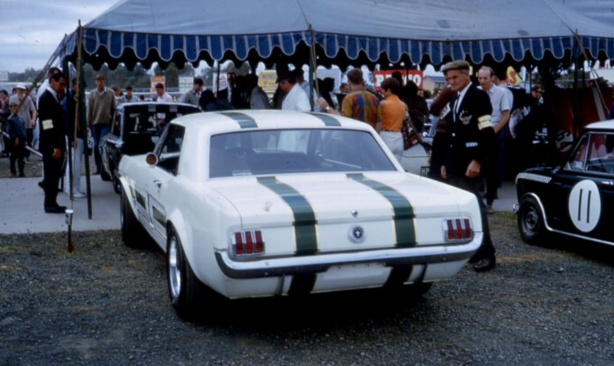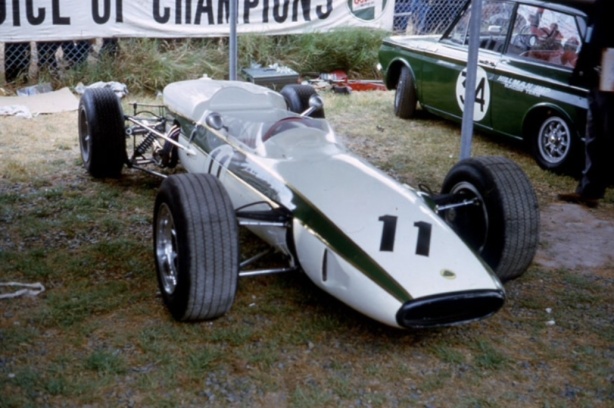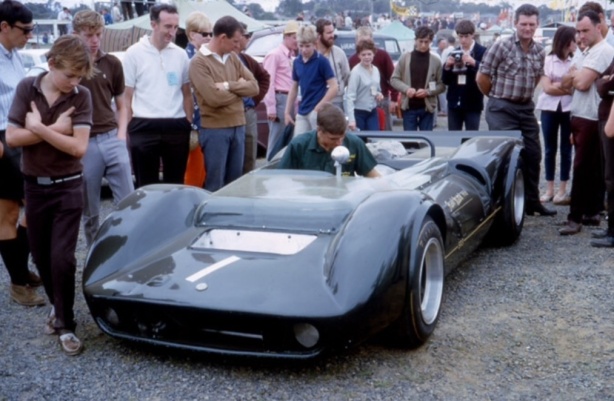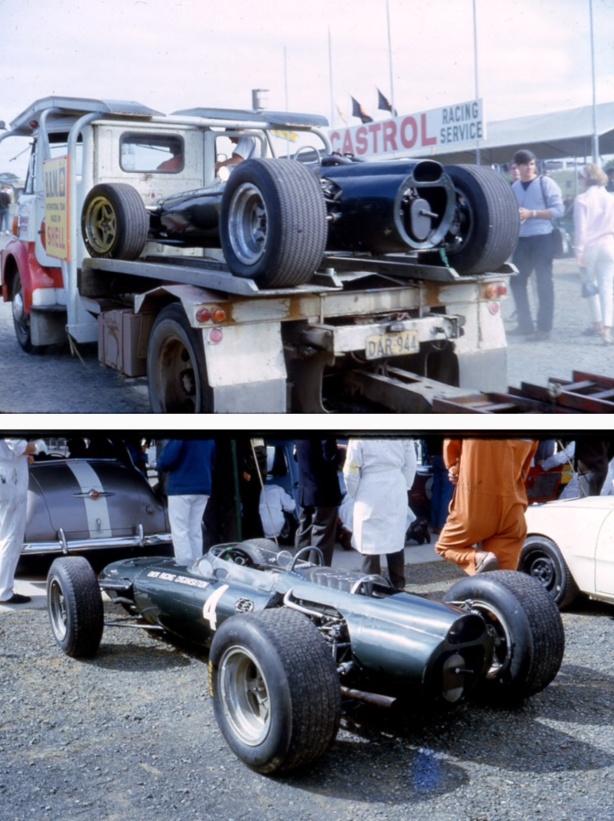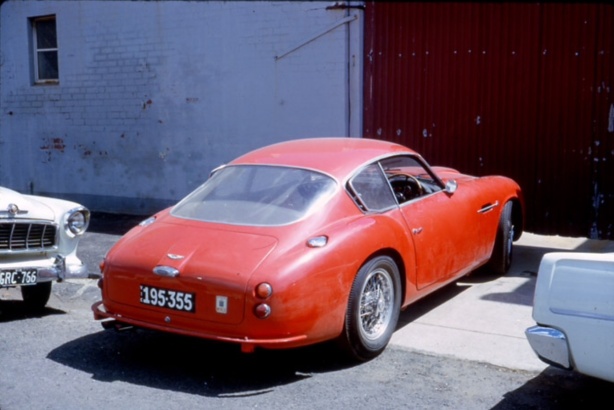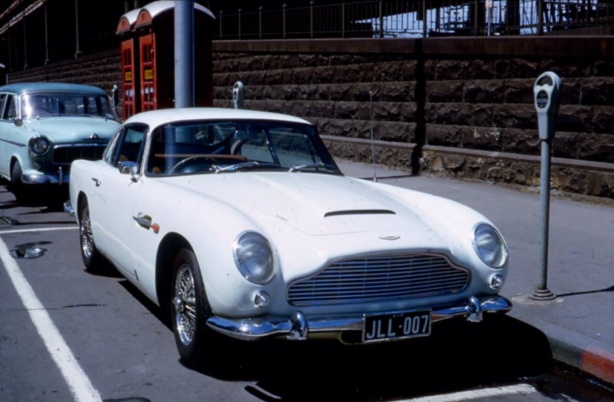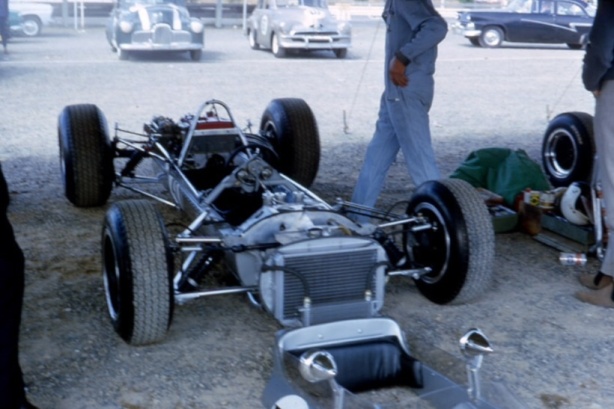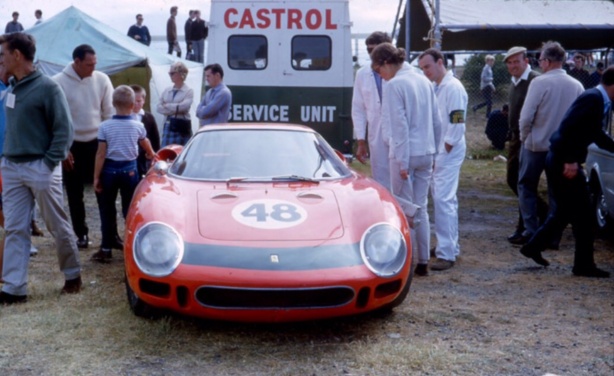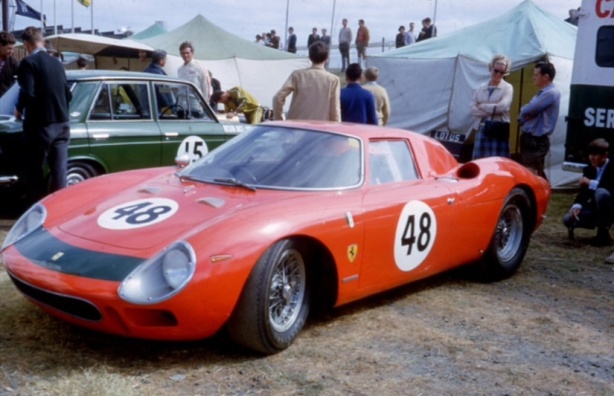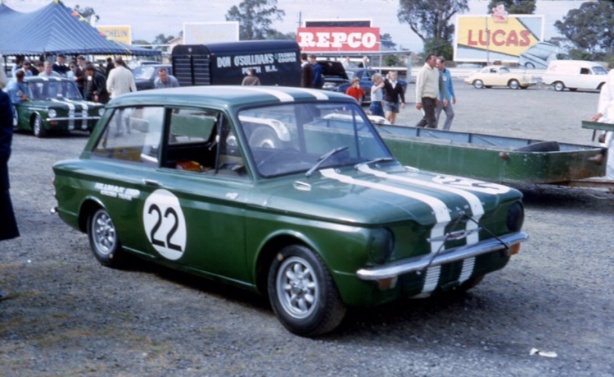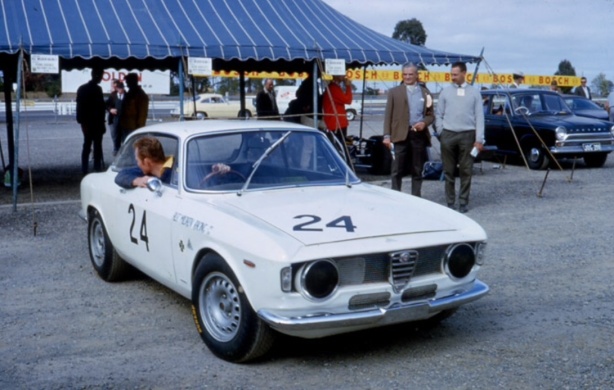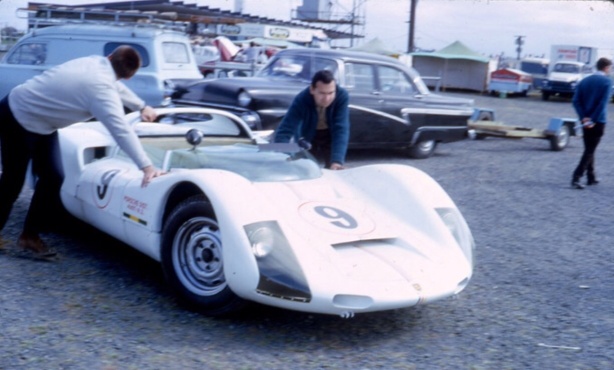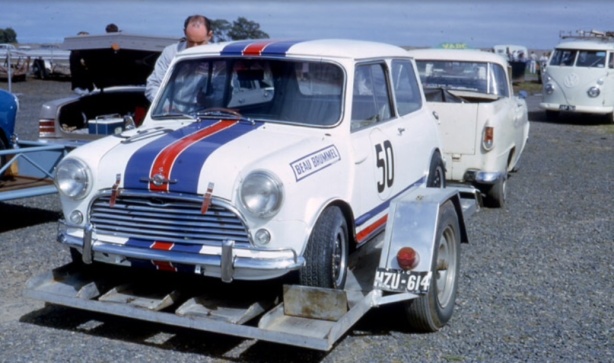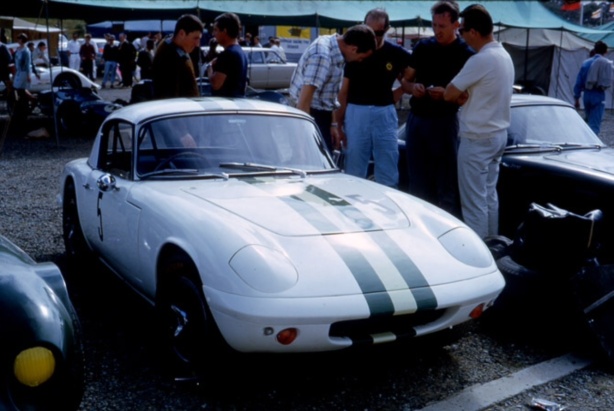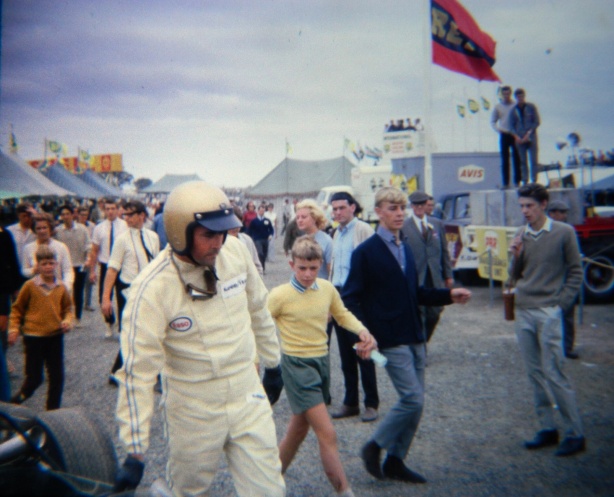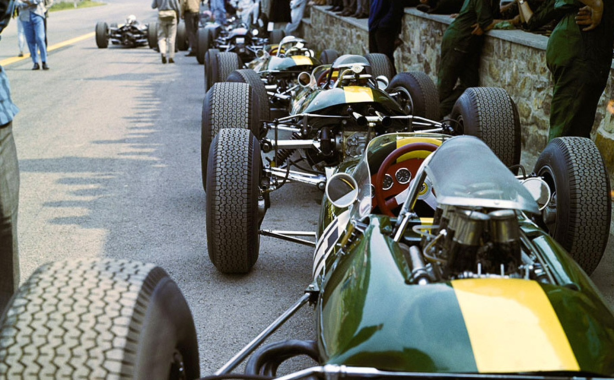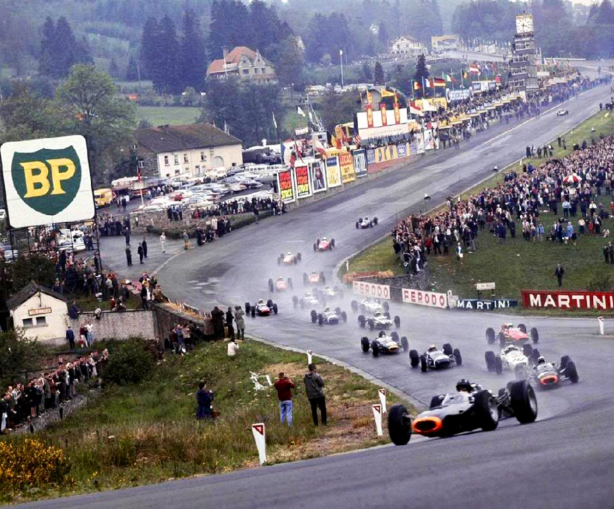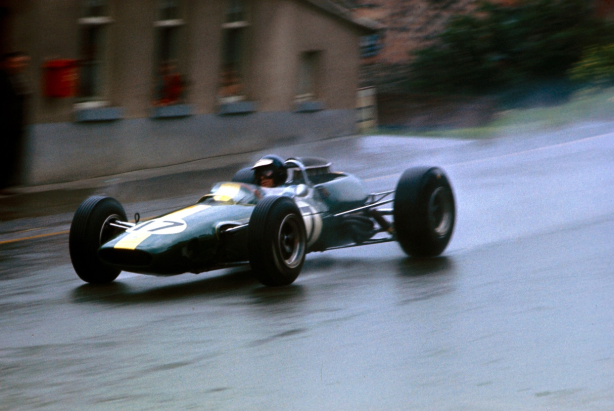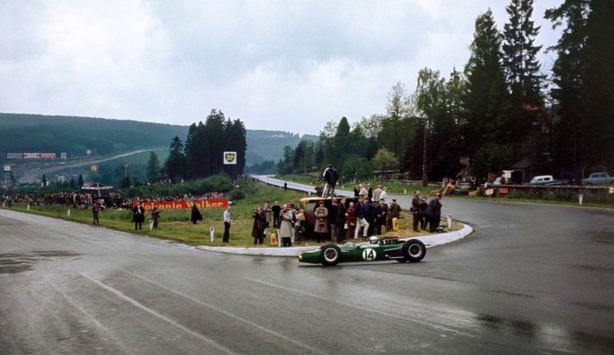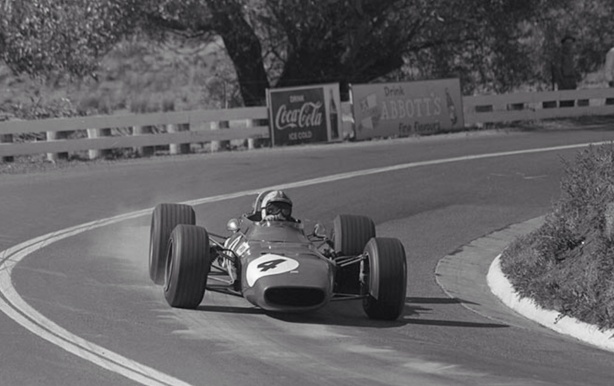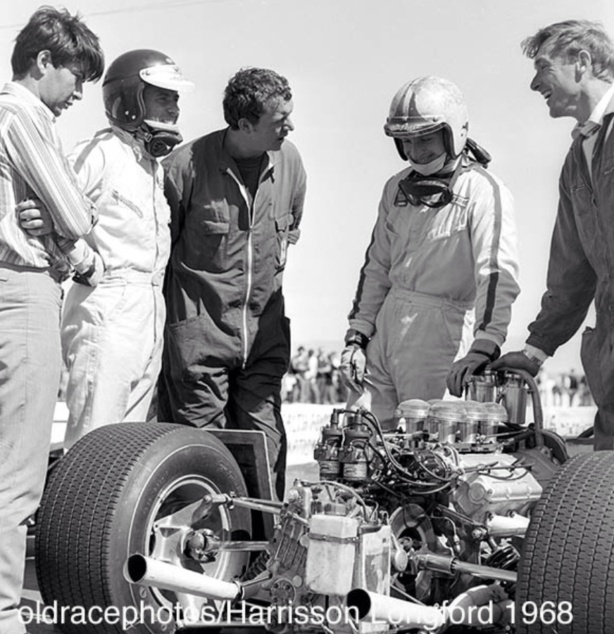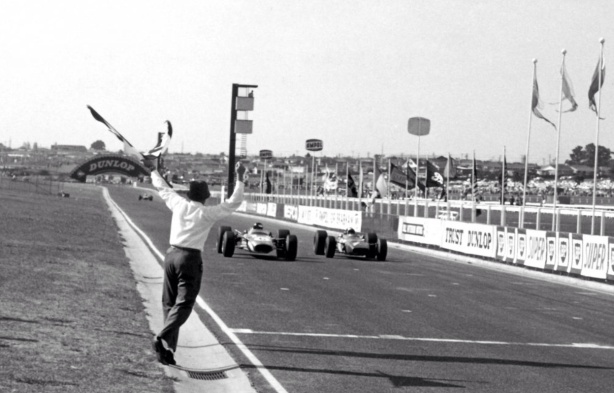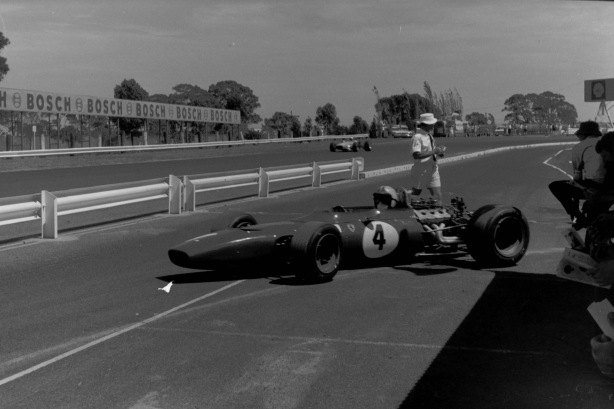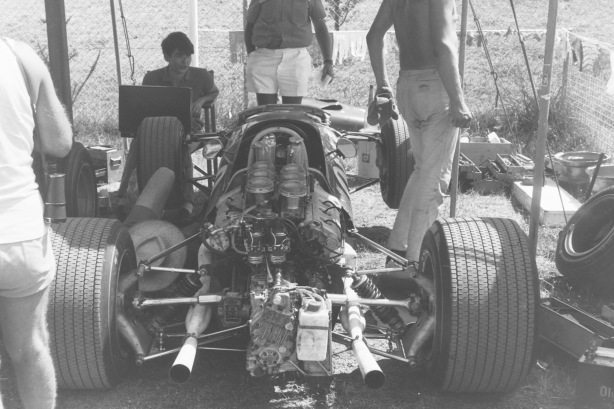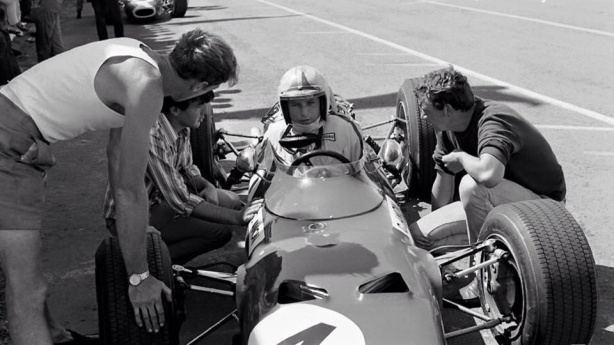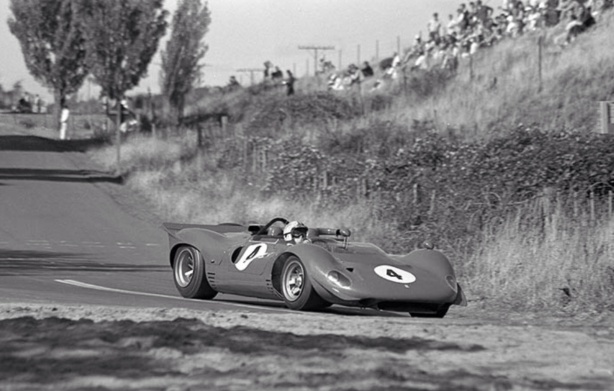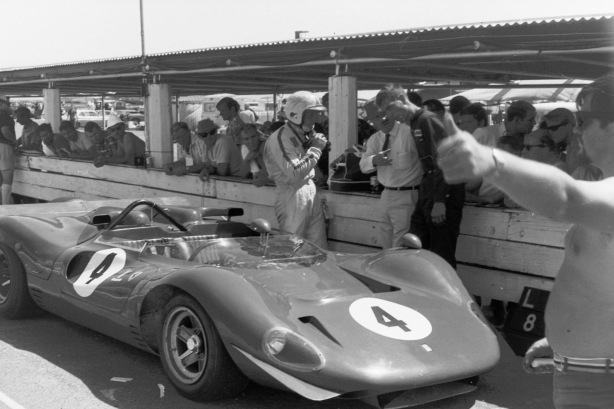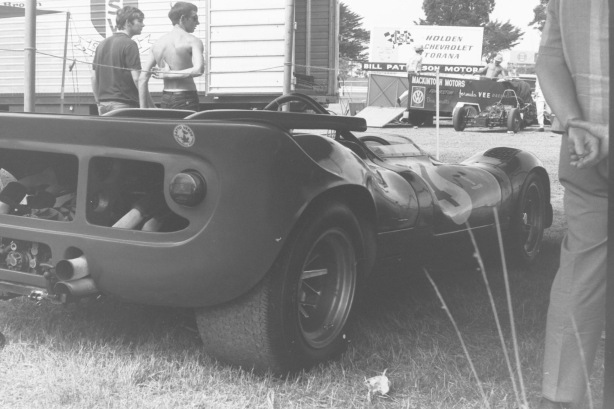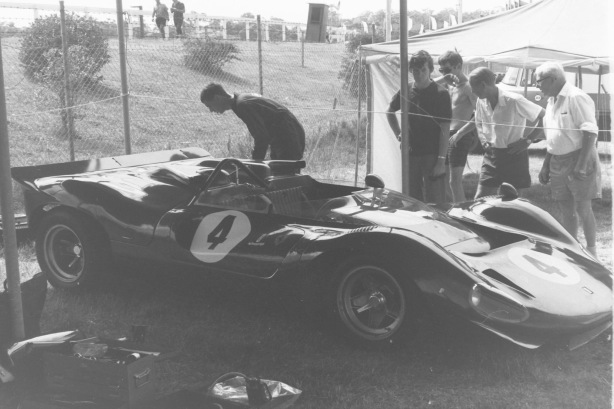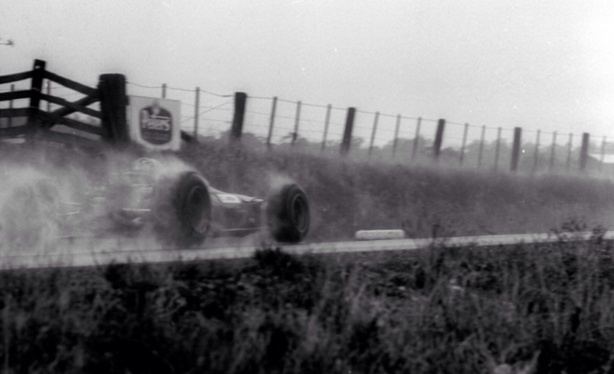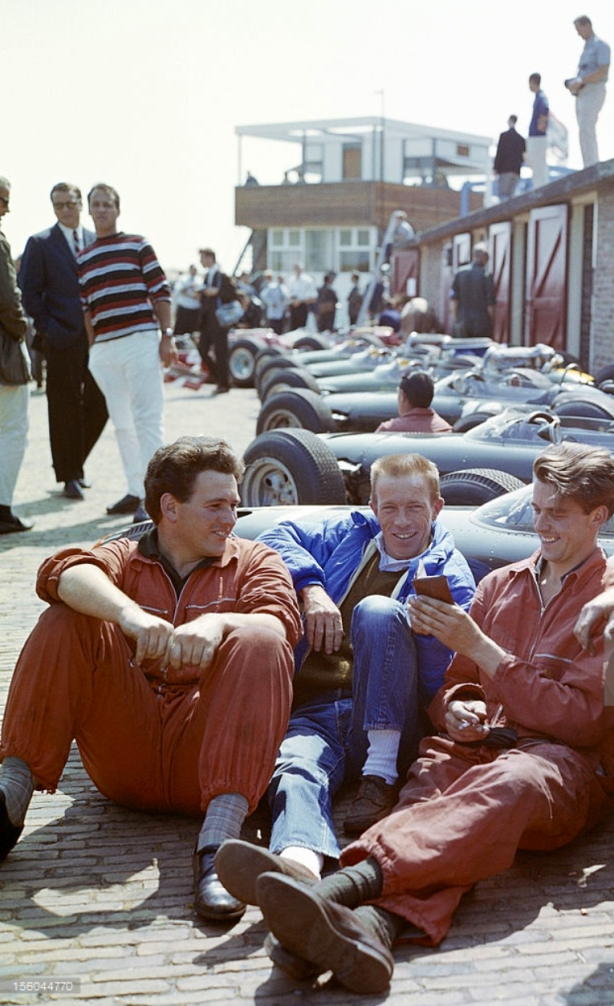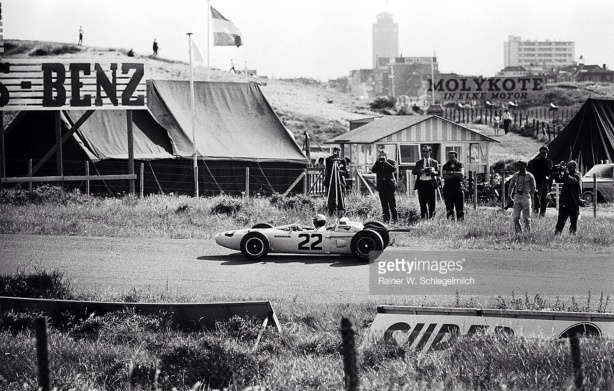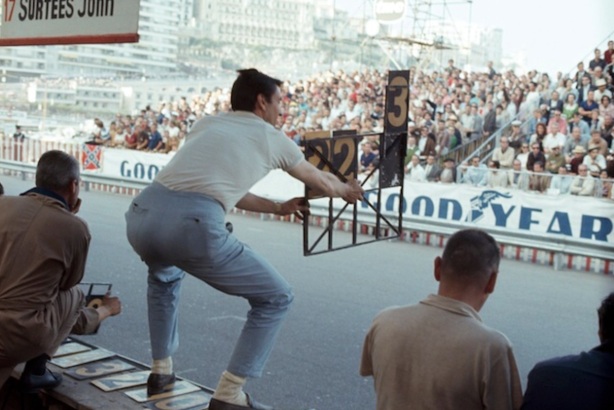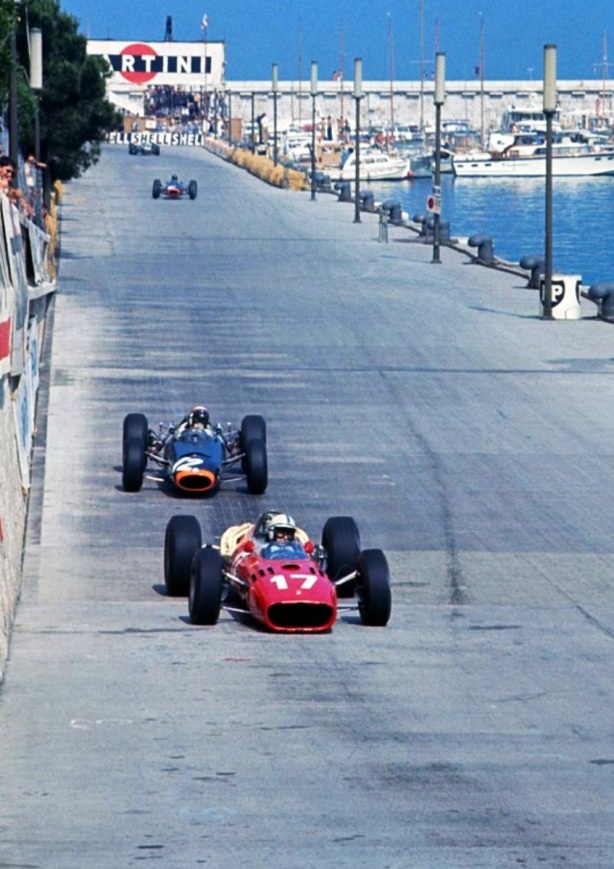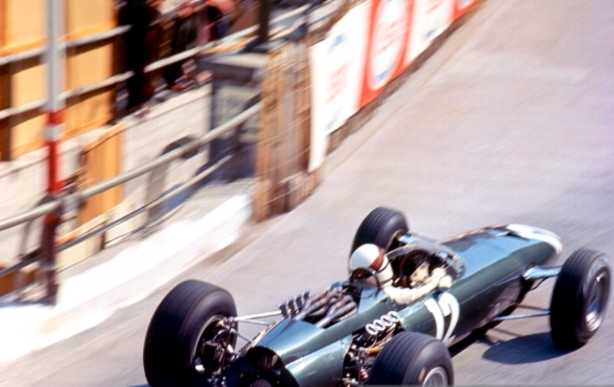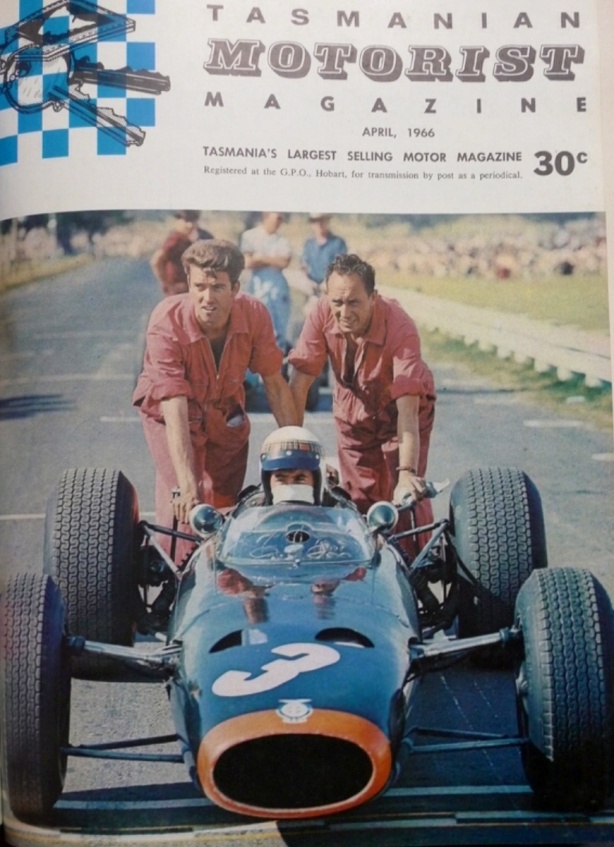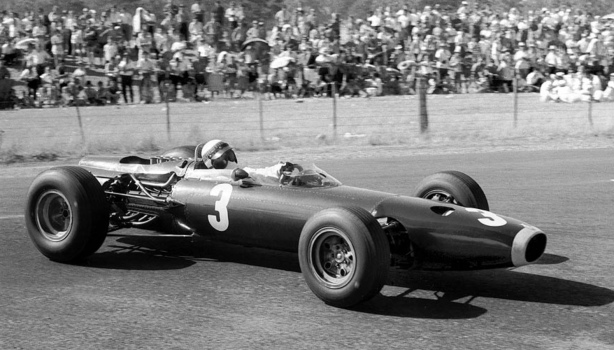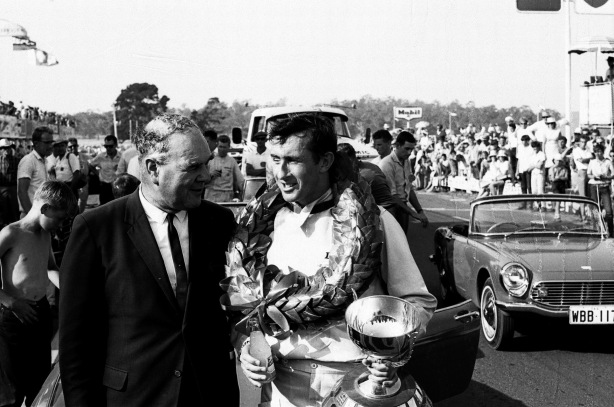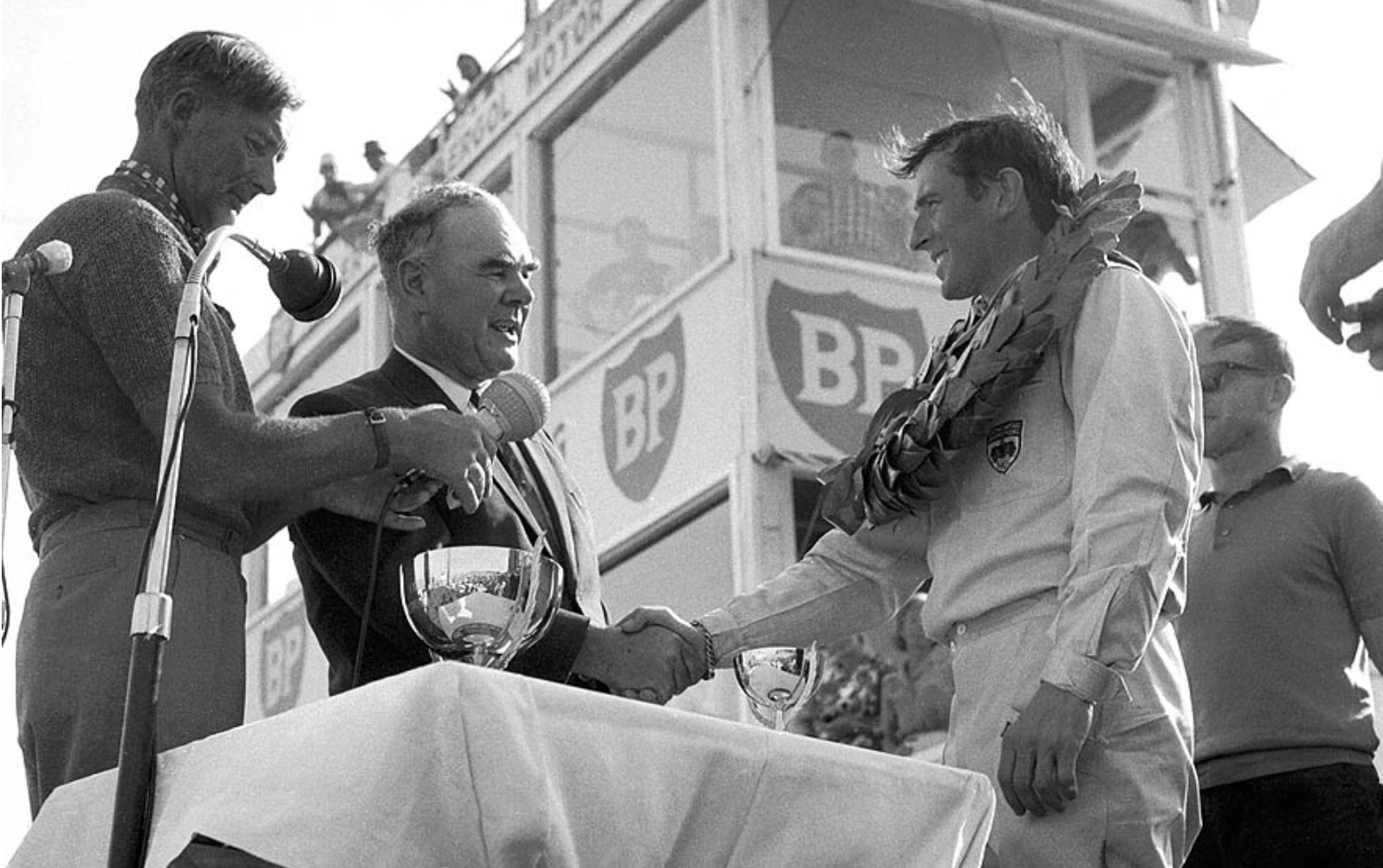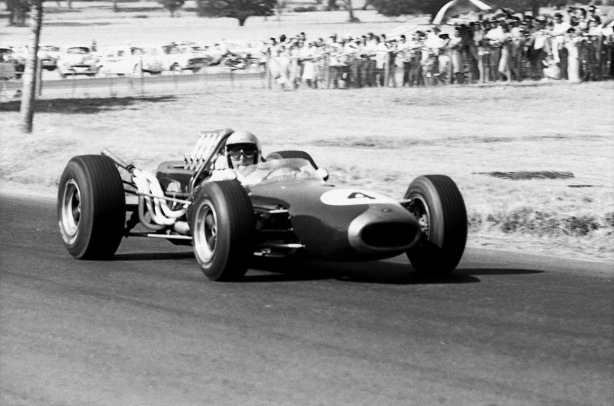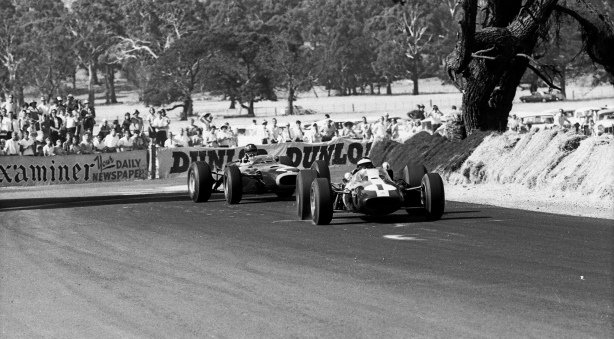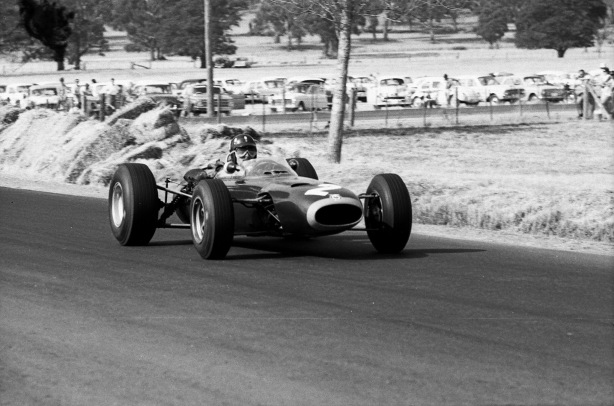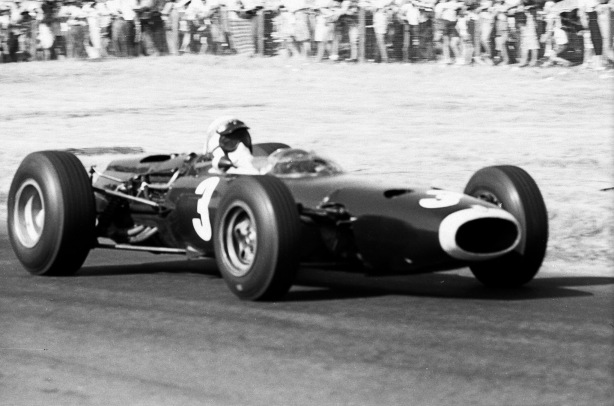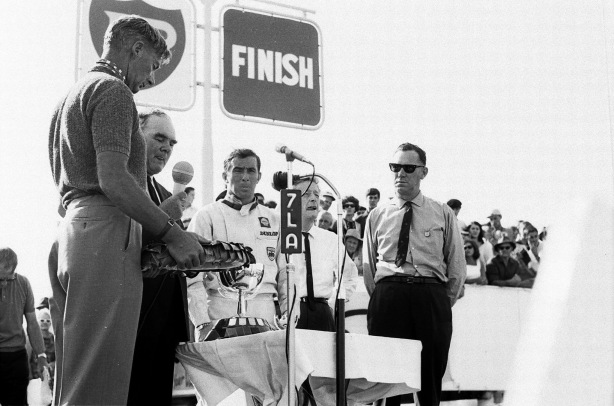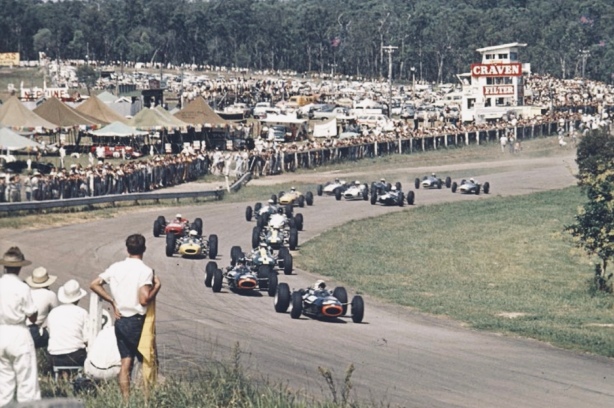
(R Bell)
Stewart, Hill, Clark, yellow nosed black bodied Gardner, Palmer looking like Clark, Martin in red and Geoghegan white- BRM P261 by two, Lotus 39, yellow nose Brabham BT11A, Lotus 32B of Palmer, red Brabham BT11A of Martin (all but the BRM’s Coventry Climax FPF powered) and Leo’s white Lotus 32 Ford. AGP- the off 20 February 1966 and what a marvellous vista Lakeside is…
The front row of the grid pretty much summed up the 1966 Tasman Cup, the two BRM P261’s driven by Hill and Stewart, two of the finest racers of their time were the class of the field powered by 1.9 litre versions of the ‘P56’ V8’s which won so many races during the 1961-1965 1.5 litre F1, they were quickest cars on the circuit throughout the weekend right from the first session on Friday having recorded laps of 55.5 and 55.8 for the Brit and Scot repectively.
Much of the pre-race press interest centred on the strong BRM presence which included three chassis ‘Graham Hill driving the same car with which he won the 1965 Monaco and US Grand Prix’ and a team of three mechanics, Rivers Fletcher doing public relations all led by Team Manager Tim Parnell- lets come back to BRM’s Australasian representation in a little bit.
Lakeside razzmatazz included girls dressed in chequered flag bikinis, a bagpipes group and a brass band in addition to the on-circuit attractions which included international drivers Clark, Hill, Stewart and Gardner.
David Harding, secretary of the Queensland Motor Sporting Club, quoted the total value of the cars at $A300,000…
Stewart had a huge points lead going into the Lakeside meeting with much expected of Clark after his first win of the series at Warwick Farm the week before.
In New Zealand Graham Hill showed BRM’s form early, winning the opening round, the NZ Grand Prix at Pukekohe on 8 January by 1.5 seconds from Stewart, in P261 ‘2616’ before returning home to the UK to continue tyre and other testing duties. He travelled back south arriving at Mascot for the first of the Australian races, the ‘Warwick Farm 100’, on 13 February.
Richard Attwood won at Levin the following weekend after Stewart had gearbox selector problems having completed 9 laps- Jim Clark was second and Spencer Martin third, Jackie Stewart continued the Bourne boys great form and won the Lady Wigram Trophy at the Wigram RNZAF base the following weekend of 22 January.
Stewart completed a clean sweep of the first four races for the P261 before crossing ‘The Ditch’- the Tasman Sea for Australia- Jackie won the Teretonga International from Frank Gardner and Jim Palmer- the latter had a great season of speed and reliability in the Lotus 32B chassis aboard which Clark took the Tasman Cup twelve months before.
Teretonga wasn’t such a great race for Dick Attwood, as his car ‘2617’, was tagged from behind in the first corner ‘The Loop’ into soft earth whereupon the it rolled trapping the hapless Brit underneath- Spencer Martin and local driver Ian Dawson, also involved in the melee, jumped from their Brabhams and helped marshalls right the car and release the driver.
In fact a ‘switcheroo’ in the cars of Jackie and Richard took place at Wigram. Attwood had his ‘2614’ going like a missile in practice thanks to some judicious testing of bars, tyre pressures and ride-heights with Alan Challis, at which point, Jackie, getting the hang of this Number One Driver caper in Hill’s absence said ‘I’ll have a crack in that’- and so he did winning The Lady Wigram Trophy’ in ‘2614’ the following day.
He kept the same car at Teretonga so the machine, the front bulkhead of which was badly bent, was off for a rebuild to Bourne. It was the car Jackie had raced throughout the 1965 F1 season- ‘2617’ the strength of which would save his life at Spa in mid-1966. We will come back to the individual chassis’ later in the article.
Whilst the drivers flew to Sydney on the Monday after Teretonga Tim Parnell supervised the shipping of ‘2614’ and ‘2616’ to Sydney whilst ‘2617’ headed back to Liverpool, and thence Bourne into the tender hands of the boys in the build shop.
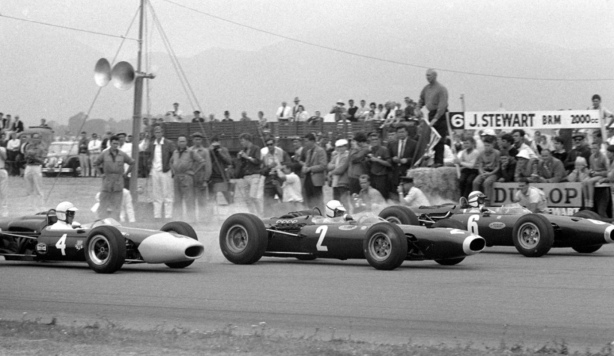
Gardner at left, Attwood, Stewart- Brabham BT11A and two BRM P261s- the off at Wigram 1966. Stewart won from Attwood and Jim Palmer with Frank a DNF after an accident on lap 4 when his brakes failed and he cannoned into Jim Clark, taking them both out of the race (Wigram)
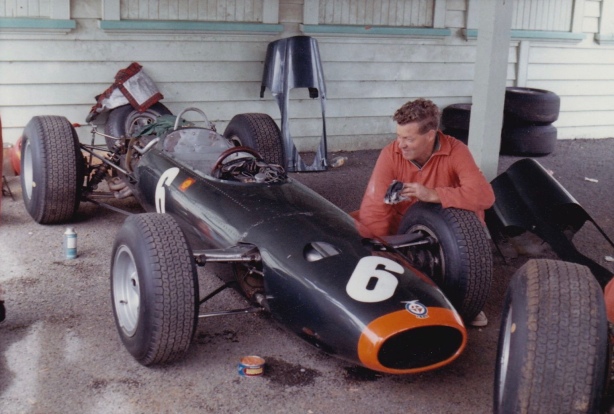
Under the Tote building, Pukekohe. JYS’ P261 chassis ‘2617’, in all of its elegant glory, 1966. Which of the BRM mechanics is it folks? The car is fitted with a P56 type 1930cc engine- inlets between the Vee and exhausts exiting thru the ‘letterbox’ orifice in the side of the monocoque, in BRM speak. Note the colour of the car, red nose band, big BRM badge and air relief ducts atop the nose and tail section leaning up against the wall (CAN)
At Warwick Farm Jim ran away and won by 21 seconds from Hill, Gardner, Stewart, Martin and Palmer, click here for a piece on that meeting; https://primotipo.com/2018/07/03/1966-warwick-farm-100/
Clark had carburetion problems with his 2.5 litre Coventry Climax FPF engine throughout the Lakeside weekend but still managed to pop the car onto row two of practice on the two by two car grid together with Frank Gardner’s similarly powered Brabham BT11A. The Lotus 39 was another mighty car from the Lotus 25/33 continuum but the good ole FPF was struggling a bit from 1966 given the entry into Tasman racing of the BRM and Repco V8’s.
Spencer Martin in the Scuderia Veloce BT11A, and Leo Geoghegan going like a jet in his Lotus 32 was the first of the ANF1.5 twin-cams, a mighty impressive performance on this power-fast-100mph lap average circuit.
Jim Palmer and Greg Cusack shared the next row and the rest- Bartlett, McDonald, Harvey, Andy Buchanan Denis Marwood, Mel McEwin and local boy Glynn Scott rounded out a small field after ‘CAMS cut the grid from 20 to 15 cars’ in the interests of safety.
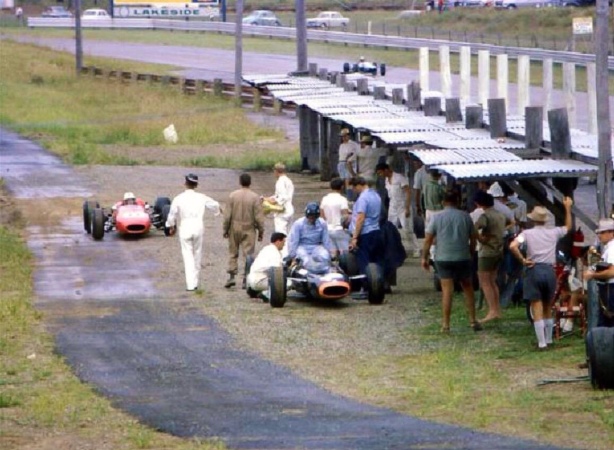
Graham Hill alights his BRM whilst Spencer Martin’s Brabham BT11A Climax enters the paddock- Glynn Scott, Lotus 27 Ford twin-cam 1.5 approaches in the distance. This is the damp Saturday afternoon session (K Drage)
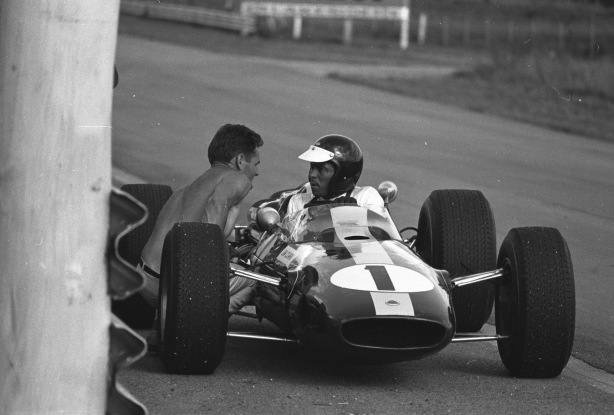
Magnificent photograph of mutual respect and affection, racer/mechanic Ray Parsons and Jim Clark ponder the next change (B Thomas)
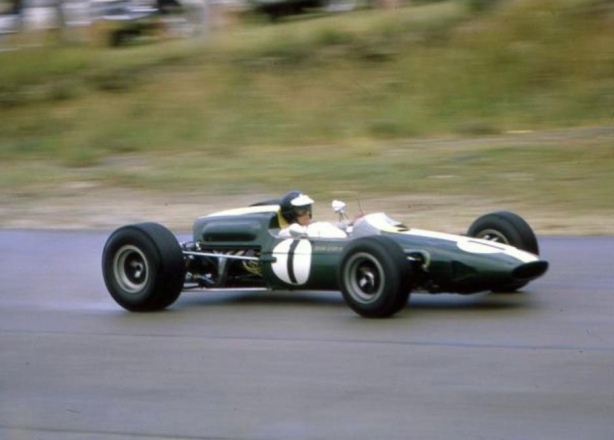
Clark in the very sweet Lotus 39 Climax on Saturday afternoon in the wet- exiting The Karussel (K Drage)
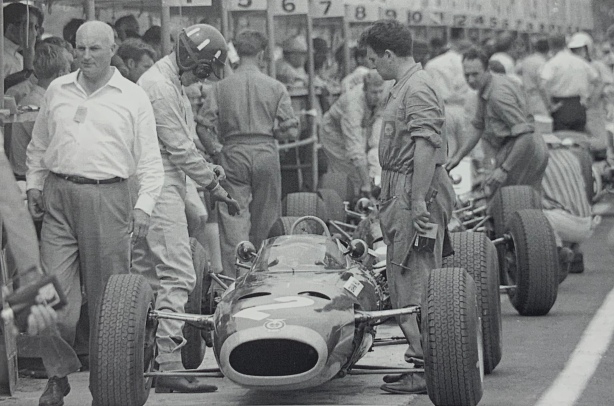
Lakeside 20 February 1966. Dunlop’s Vic Barlow at left, Hill suiting up and ‘Dobbin’ Challis beside Graham’s ‘2616’ whilst Jimmy Collins and Stan Collier look after Jackie’s ‘2614’ behind (BRM 3)
Sunday dawned cloudy and hot, the crowd got a magnificent days motor racing on this, the first occasion Lakeside held an AGP, for their four-dollar entry fee!
In addition to the feature race there were two 10 lap heats for the Tasman cars both won by BRM- Hill won the first from Gardner and Martin and Stewart took the second from the Clark and Geoghegan Lotuses.
Stewart and Hill settled into their front row grid slots and howled away from the off- Stewart, Hill, Clark and Gardner led the high speed train, then Martin, Palmer and Geoghegan.
Cusack got by Geoghegan on lap 5 with ‘Hill tied to Stewart as if by string’, Stewart set a scorching pace from the start, thrilling the crowd, despite this Hill was close behind and always within striking distance.
The race developed into three tough fights between Stewart and Hill up front, then Clark just ahead of Gardner and then a flying wedge of Palmer, Cusack and Geoghegan.
’The race pitch at this point had the crowd running from vantage point to vantage point, a rare thing in open-wheel competition, and to really set the seal on the excitement, the tail closed up and made a magnificent show as Marwood, Harvey, Buchanan, McDonald and Scott raced wheel to wheel’ Des White wrote in his HAGP race report.
Stewart’s gearbox cried enough on lap 28- it was this element of the BRM P261 which became its weak link at 1.9 litres and even much more so at the 2.1 litre capacity the Bourne team raced these cars in the 1967 and 1968 Tasmans.
’Stewart was very hard on gearboxes…Hill suffered persistent clutch slip in the last two races, but otherwise the BRM’s were very reliable. So they should have been too, with the massive Owen group effort which included a public relations man’ wrote Bill Tuckey. Bill is a bit hard on Jackie, the ‘box was the problem not JYS lack of mechanical sympathy.
Then Cusack clipped Palmer in the Eastern Loop when Jim braked a little early and Leo kissed Greg causing Cusack to spin and Geoghegan to re-enter the circuit 100 metres down the road- both retired with bent or busted suspension components shortly thereafter.
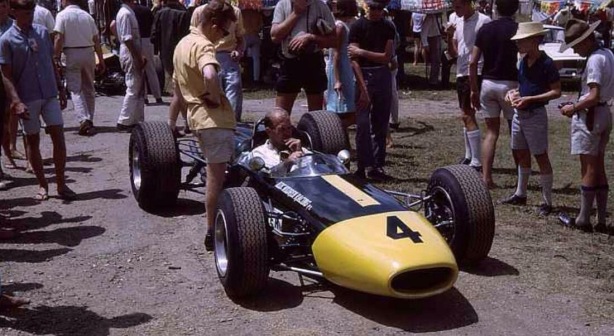
Frank Gardner in one of two Brabham BT11A’s Alec Mildren Racing raced that summer, Climax engined, the other was Maserati 2.5 V12 powered and ran in Warwick Farm and Sandown practice- pre-race hype promoted the Brabham Maserati at Lakeside but the car did not make the trip from Sydney (unattributed)
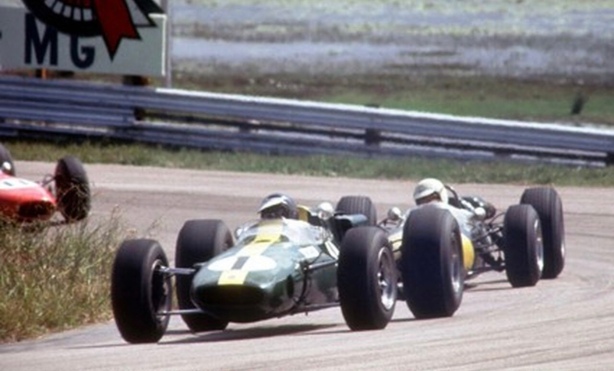
Jim Clark from Frank Gardner with Spencer Martin’s Brabham BT11A just back a bit- third, second and DNF clutch (autopics.com)
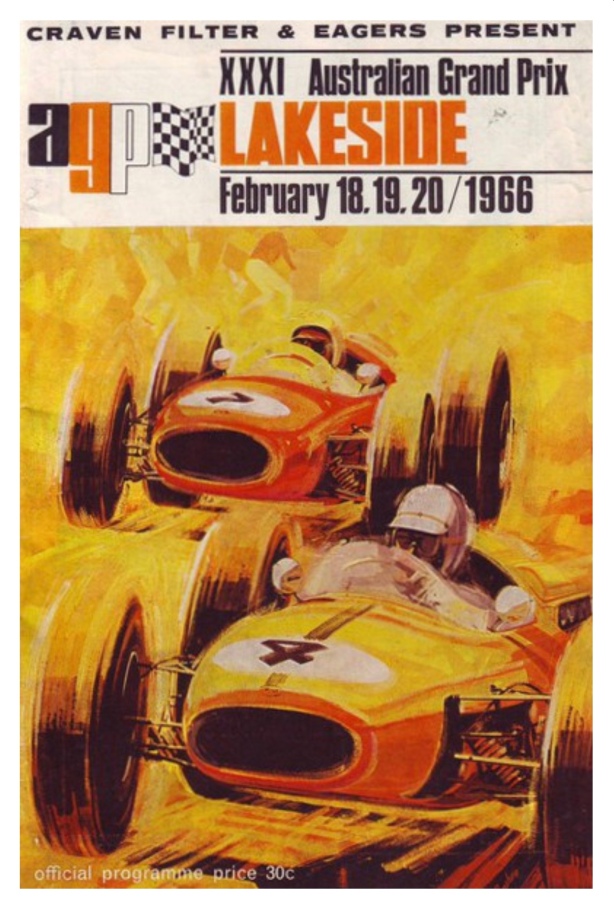
Frank Gardner was still pushing Jim Clark hard- he had a great summer in Mildren’s BT11A with better FPF reliability than some- but FG was mighty quick too, i’m not implying his results were solely due to reliability. Then Jim’s Climax took a turn for the worst- losing its edge further so Frank was through to second from Hill up front- Hill won at an average speed of 94.9mph from Gardner, Clark and Palmer.
Hill and Stewart both did equal fastest laps of 55.9 seconds- one second adrift of Clark’s 54.9 second lap record set in the Lotus 32B the year before. Kevin Bartlett’s Alec Mildren Racing Brabham BT2 Ford was the first of the ANF1.5s home in another drive which convinced Mildren KB was ready for the step up into the more demanding 2.5s- something he did with great aplomb later in the year.
Clark’s carburetion problems persisted throughout the series and were solved by John Sheppard when the car passed into his care after Leo Geoghegan acquired it by the simple expedient of solid carburettor mounts.
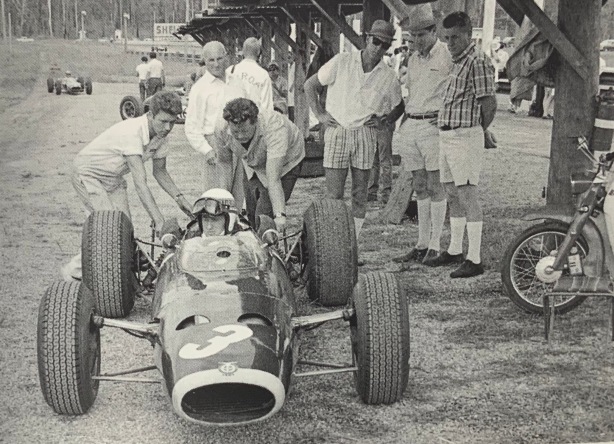
Jackie fires up the now ‘Central exhaust’ P68 powered ‘2614’ before heading out of the Lakeside paddock. Jimmy Collins, Vic Barlow and Tim Parnell watched by a group of local enthusiasts (BRM 3)
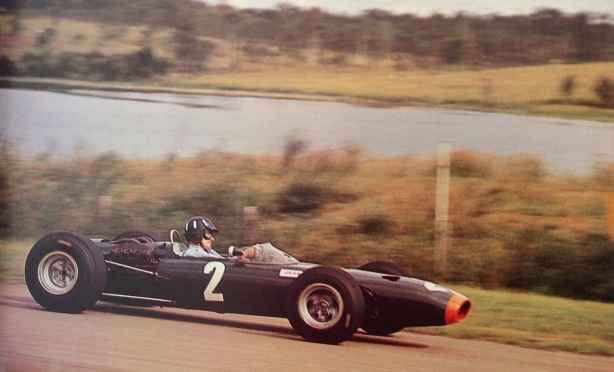
(HAGP)
Graham Hill nose up at Lakeside in a car that was so kind to him- the BRM P261, a machine with which he was synonymous, not the BRM he used to win his 1962 World Title but one he raced from 1963 all the way into 1966 with the H16 BRM P83 duly recognised.
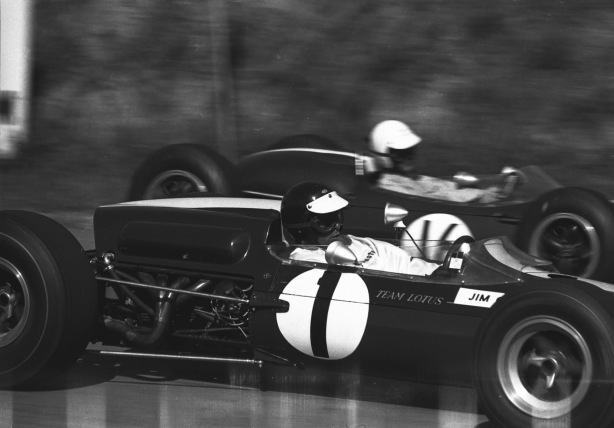
(B Thomas)
Jim Clark with Andy Buchanan on the outside, Brabham BT7A Climax, who finished seventh.
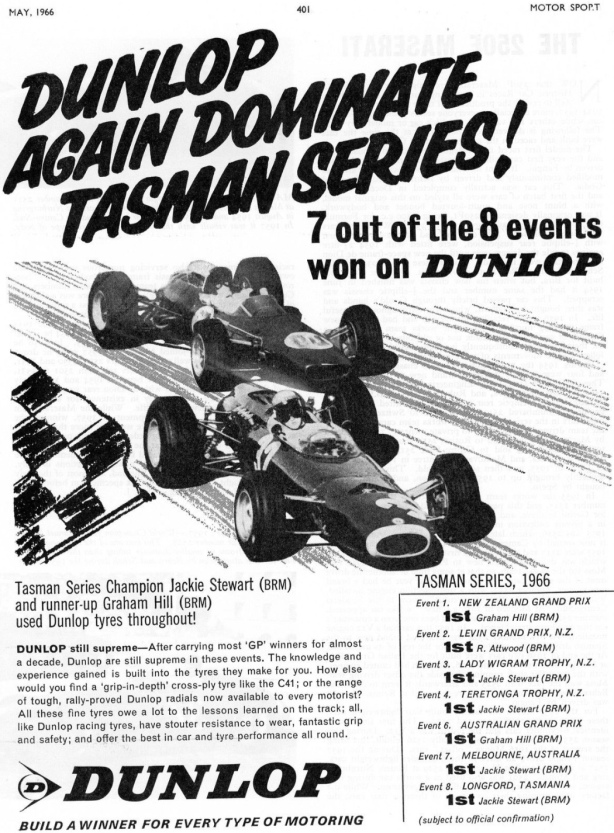
BRM and The Antipodes 1966…
The Owen Organisation had extensive business interests in Australasia (it would be interesting to create a list of the British transnational’s subsidiaries in this part of the world at the companies height) and had of course raced here before- Ken Wharton thrilled Kiwi crowds in a P15 V16 in 1954 at Ardmore and Wigram and Ron Flockhart did all of the NZ Internationals in a front-engined P25 in 1959 whereas the 1961 campaign was a full works representation of two P48 mid-engined 2.5 litre F1 cars- these were raced by Graham Hill and Dan Gurney and on this occasion the visitors came to Australia as well as New Zealand. See here; https://primotipo.com/2019/11/18/ken-wharton-and-brms-grand-turismo-south-in-1954/ and here; https://primotipo.com/2018/03/16/bourne-to-ballarat-brm-p48-part-2/
The local promoters led by Ron Frost (NZ) and Geoff Sykes (Oz) had been doing their job in trying to seduce BRM back here and had a ‘red-hot go’ for 1965 given by that stage BRM had an 1880cc ‘P60’ version of their P56 V8, it was thought the P261 so powered would have been competitive with the 2.5 litre (mainly) Coventry Climax engined ‘Tasman Special’ Brabhams and Lotuses.
In essence Tasman races were 100 miles and had no minium weight limit whereas GP’s were 200 miles in duration and the cars had minimum weight limits so Ron Tauranac’s ‘Intercontinental’ Brabhams, for example, were designed and built to the Tasman formula or rules. Tony Rudd, backed by Graham Hill, felt the P261 at 1880cc would not be a competitive Tasman Cup mount in that the cars would be too heavy and not powerful enough- underlying their opposition (in a document reproduced by Doug Nye in BRM 3) was the (correct) belief that the Tasman program would detract from their 1965 F1 program in the same way Sir Alfred Owen’s BRM-Rover turbine Le Mans racer grabbed scarce resources in 1963 and 1964- it too was foisted upon Rudd and ORO (Owen Racing Organisation) at short notice.
However, in late 1965 Sir Alfred was resolute, the broader commercial needs of the Owen Group (the establishment of an Austin-Morris production facility in NZ, with Owens to provide the necessary components) were met by having ORO’s presence in the 1966 Tasman Cup and as a consequence the team had to ‘make it work’ despite being up to their armpits in the new for 1966, immensely complex, BRM P83’s H16 engine.
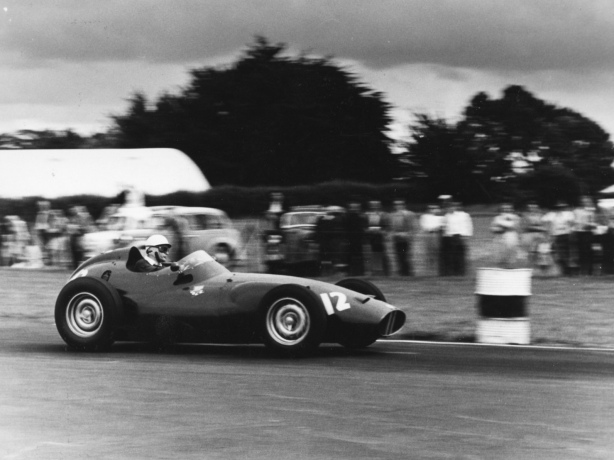
Ron Flockhart, BRM P25 during the 10 January 1959 NZ GP on the Ardmore airfield circuit- DNF oil leak, the race won by Stirling Moss’ Cooper T45 Climax FPF 2 litre (Ardmore)
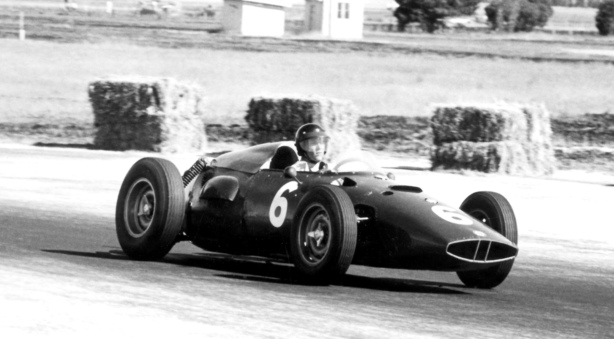
Dan Gurney on the way to the BRM P48’s only International win, the Victorian Trophy at Ballarat Airfield, Victoria 12 February 1961 (unattributed)
Geoff Johnson and his engine design team squeezed the P56 V8 up again from 1880cc to 1916cc and then 1930cc- the latter became the definitive 1966 Tasman spec engine used throughout that summer.
These motors gave between 260 and 270 bhp, which despite the weight of the P261 chassis, was more than enough to trump the circa 240bhp ‘Tasman Specials’. These motors and P61 Mark 2 chassis ‘2616’ Graham’s regular 1965 F1 car first raced to a win by him upon its debut at Watkins Glen in 1964, Jackie in his normal ‘2517’, the last P61 built during the winter of 1964-5 for JYS debut season, and old ‘2614’, first raced by Graham in the 1964 Aintree 200 and used as the team spare throughout 1965 were sent to New Zealand on the SS Tasmania Star which left Liverpool on 29 November and arrived in Auckland on 23 December.
Of interest is that ‘2616’ lives as does ‘2614’ whereas ‘2617’ whilst destroyed and scrapped after Jackie’s death defying 1966 Spa crash was recreated for Richard Attwood as ‘2617R’ in the late nineties- a lovely bit of symmetry given Richard rolled it at Teretonga in 1966 when he was part of others ‘moment’. Finally, for the record, a total of one P61 Mk 1 was built, chassis ‘611’ and six P61 Mk 2’s- chassis ‘2612’ to ‘2617’. The P61 Mk1 ‘611’ was scrapped in 1963 but all of the P61 Mk2’s live, thank goodness.
Despite broken ring problems in testing at Bourne, with a very careful running regime when a motor was first used which involved abnormally large amounts of engine oil in the fuel- the motors proved very reliable throughout that summer- a bonus for Team Manager Tim Parnell and the mechanics- Allan Challis, Jimmy Collins and Stan Collier, the later seconded by Parnell.
One of the compromises made to meet the needs of preparation for the new 3 litre F1 as well as being competitive in Australasia was the appointment of Tim Parnell as Team Manager and secondment of Stan Collier into the ORO group for the trip rather than Tony Rudd and another BRM mechanic make the trip.
Son of Reg- Tim was a racer to the core who had stepped very ably from the cockpit to running his fathers F1 race team upon Reg’ sudden death in January 1964 and was well known to BRM as a customer using BRM V8’s and cars for some years.
And so the scene- cars, engines, drivers, technicians and team management were put in place for an immensely successful summer in competition and commercial terms- seven of eight championship rounds and nine of ten races won with the Tasman Cup secured by Jackie Stewart bolstering even further BRM’s ‘cub’ drivers confidence who had already won his first GP in his first F1 season of 1965 at Monza no less.
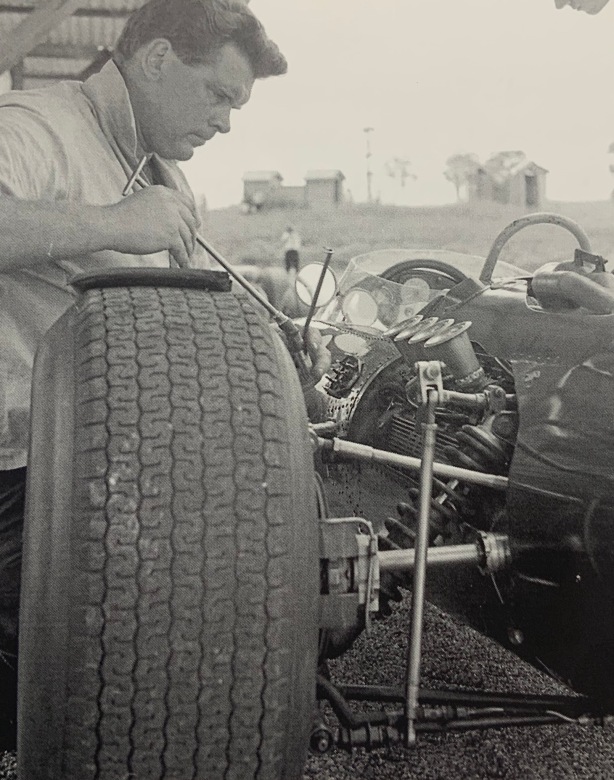
‘Technical Tim- plug changing on Graham’s ‘2616’. Very popular, avuncular Tim had spent his entire life in racing and farming- thanks to his father- former BRM V16 driver and pig-breeder Reg Parnell. Tim had been a racing driver before his father’s untimely death in 1964, whereupon he had taken over full-time management of Parnell Racing’ wrote Doug Nye (BRM 3)
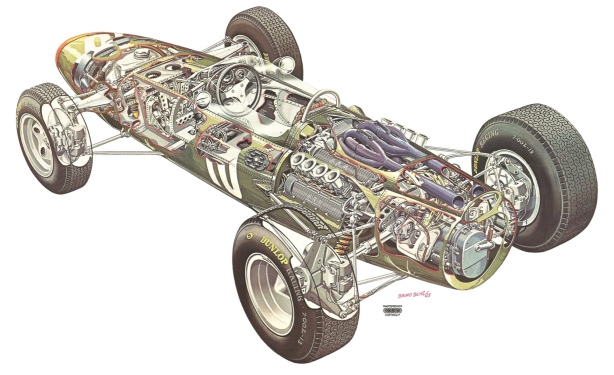
(B Betti)
BRM V8 Engine Types/Designations…
I wrote an article about the ‘Stackpipe’ BRM P57/578 in which Bourne and Graham Hill won their 1962 titles and covers the P56 engine in a bit of detail which still stacks up ok, see here; https://primotipo.com/2016/02/05/motori-porno-stackpipe-brm-v8/
It is a bit wanting in terms of the ‘P56’ engine derivatives though, so, having picked over ‘BRM 3’ Doug Nye’s treasure trove of all things Bourne here is a summary of the motors if for no other reason than to provide myself a simple list to refer to the next time i tangentially cover this amazingly, long lived series of race engines.
‘P56’ 1.5 litre V8
Initial design as per the link above- 68.5mm bore and 50.8mm stroke for 1497.7cc. DOHC gear driven two-valve Lucas injected with ‘conventional’ cross flow disposition of inlet and exhaust valves
The engines first drawings of 300 in total were issued in January 1961, the first batch of components received in April 1961, assembly of the engine commenced that June with the first one fired up on 12 July 1961
170bhp was produced by the end of August with the engine first tested against the competition at Monza over that tragic September weekend. Racing began in 1962 with the ‘Stackpipe’ exhausts fitted- 185bhp
Ongoing development gave rise to the 195bhp ‘Monza’ spec which won the 1962 championship
For 1963 a single plane crank version was developed, this allowed the use of a coupled exhaust system which gave the engine a broader power band- with development this produced 205bhp
‘P60’ 1.9 litre V8 1964
1880cc engine developed at Richie Ginther’s suggestion for the 2 litre sportscar class in the US, in original form it produced 240bhp
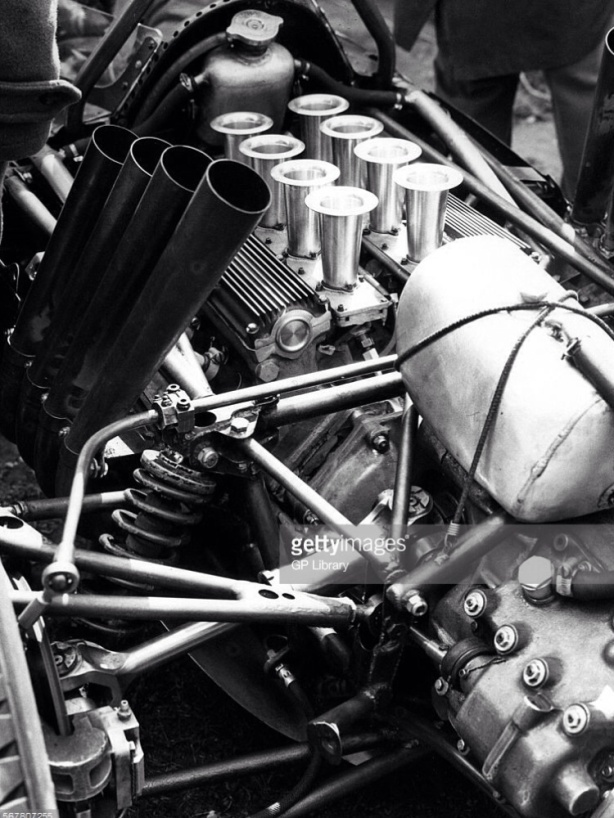
P56 1.5 litre V8 ‘Stackpipe’ nestled in one of Graham Hill’s P57/578 chassis during 1962
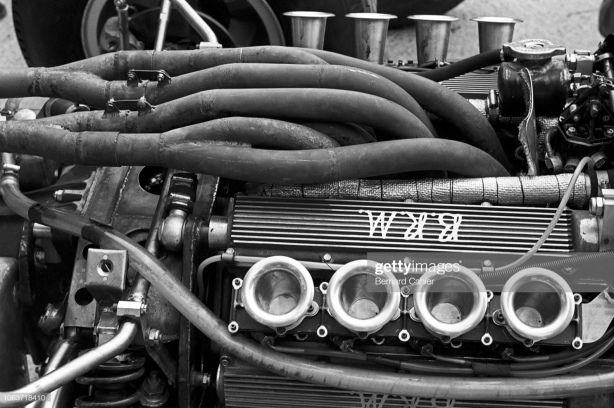
P68 1.5 V8 in the 1964 Monza paddock
‘P68’ 1.5 litre V8 late 1964
Between the Vee exhaust layout- exhaust ports in the Vee, inlets located between the cam-boxes. The space around the engine was unobstructed by exhaust pipes which allowed a stiffer tub to be built and an extra 5 gallons of fuel to be carried
First appearance Monza 1964- first win at Watkins Glen- work over the winter of 1964-5 led to engines giving 215bhp
By the end of the 1.5 litre Formula the best of the engines gave 220bhp and weighed 264pounds
2 litre V8
1916cc and the ‘definitive’ 1966 Tasman engine of 1930cc in capacity
T56 variant gave 260bhp and T68 version 270bhp- both types were used in ORO’s successful 1966 Tasman campaign as close scrutiny of some of the photographs demonstrates
1998cc sportscar version for Matra in 1956 was P56 type with the taller P123 blocks. Fitted to MS620 coupes- these engines with alternators etc designated P100
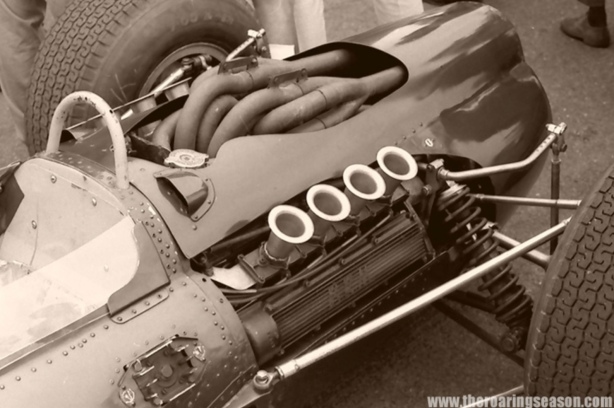
One of the P261’s in the Warwick Farm paddock in February 1966- P68 1930cc (B Wells- The Roaring Season)
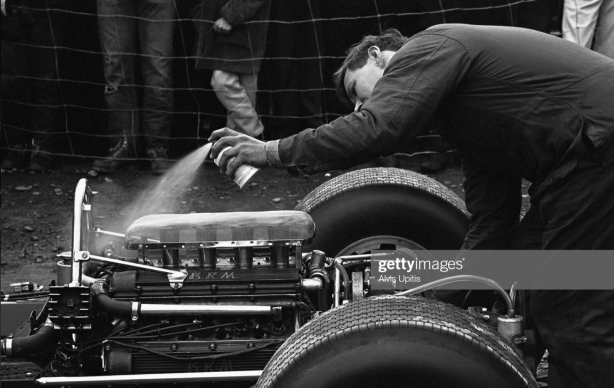
One of the BRM mechanics persuades the P56 2 litre V8 fitted to Peter Arundell’s works Lotus 33 to start during the 1966 US GP weekend at Watkins Glen. He was sixth in the race won by Jim Clark’s Lotus 43 BRM H16- famously that wonderful, complex, mad engine’s only win
P111: 2.1 litre V8
1967 Tasman and beyond specifications
Two engines built initially of 2070cc and gave 287bhp and 292bhp- used the taller P123 blocks
Six engines were converted by the time of the 1967 Tasman – 2 P56 type and 4 P68 exhaust within the Vee type. Engines very reliable, the weakness of the package was the magnesium cased lightweight P72 six-speed gearboxes which were never designed with the power and torque- and tyre grip by then being produced
Type 80: 1.5 litre Straight-four cylinder Formula 2 engine
’Half’ of one of the 2 litre V8’s – soon gave in excess of 130bhp.
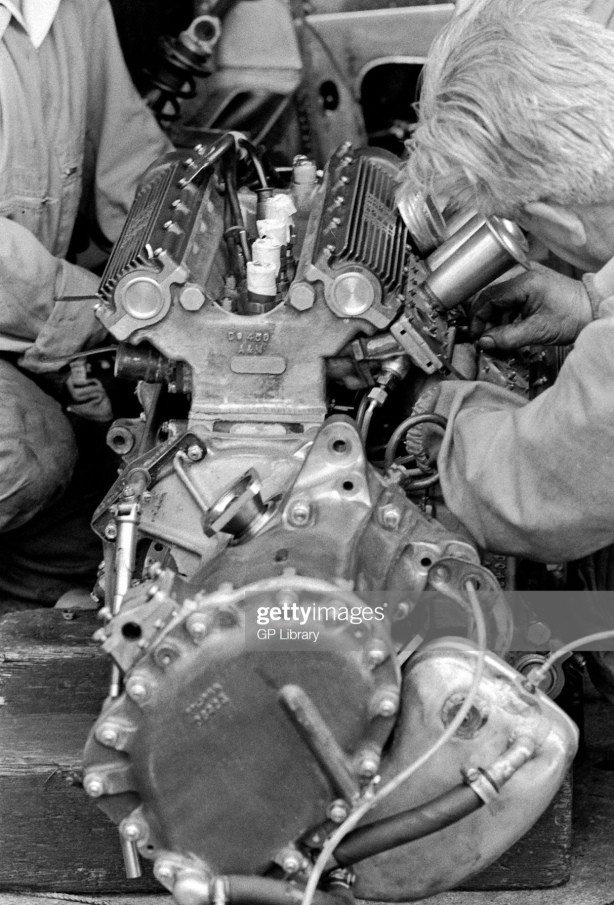
P80 1 litre, four cylinder F2 engine the size of which is ‘overwhelmed’ by the bulk of the P72 transmission
Etcetera…
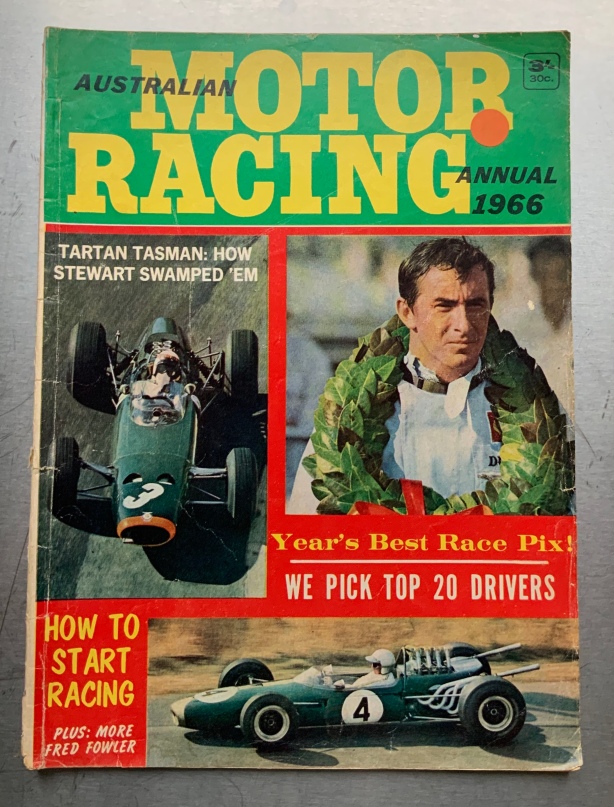
(M Bisset)
JYS was ‘top of the pops’- on the cover of ‘Australian Racing Annual’ for 1966- these annuals are much treasured and were a useful pot-pourri of the season just gone, they were published by the ‘Sports Car World’ magazine people.
Shots show Stewart on the way to victory at Longford on the entry to The Viaduct, and wearing one of the many garlands popped around his neck that summer. The shot below is Jack in BT19 complete with brand-new Repco-Brabham 620 2.5 litre V8 also at Longford.
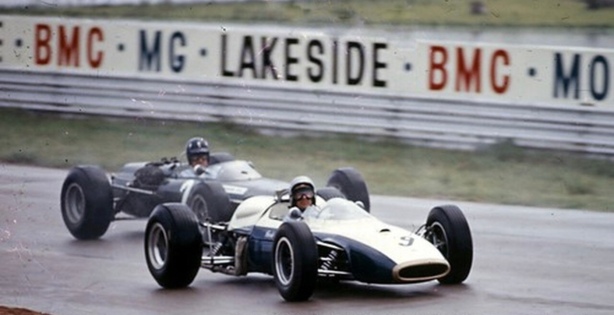
(autopics.com)
Graham Hill on the outside of Kiwi Dennis Marwood’s Cooper T66 Climax during the Sunday morning warm-up at Lakeside- DNF oil pressure in the feature race.
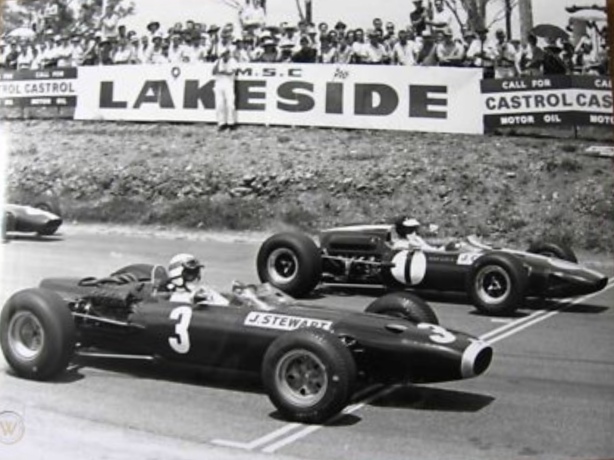
(unattributed)
Stewart and Clark off the front row of the grid during the second of the Sunday morning heats.
BRM P261 ‘2614’ and Lotus 39 Climax ‘R12’- they had some titanic dices during their Australasian summer but plenty of fun off-track and shared accommodation throughout, parsimonious Scots as they were.
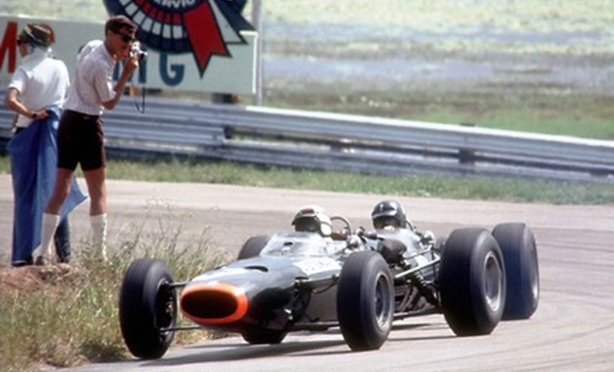
(autopics.com)
Like a rat up an aqueduct- ‘2614’ from ‘2616’…
GH has his nose shoved right up JYS gearbox which is not helpful as that unit was the weakest link of an otherwise bullet-proof remarkably fast racing car into 1969 generally- and into 1968 specifically when the one P261 which was sent to Australasia- as a support or back-up car to the new P126 2.5 litre V12 was a very popular machine particularly with Pedro Rodriguez who took any excuse he could to pop his bum into the ‘old darlin’ rather than its much younger sister.
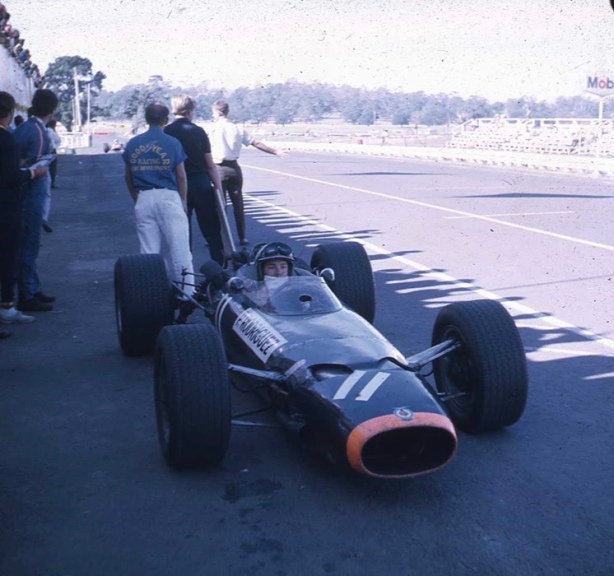
(D Cooper)
Pedro Rodriguez in good ‘ole ‘2614’ on the very last weekend a P261 was entered by the factory.
Rodriguez was second in the very soggy ‘South Pacific Trophy’ Longford Tasman round on 4 March 1968, won in fine style by Piers Courage in an F2 McLaren M4A Ford FVA 1.6.
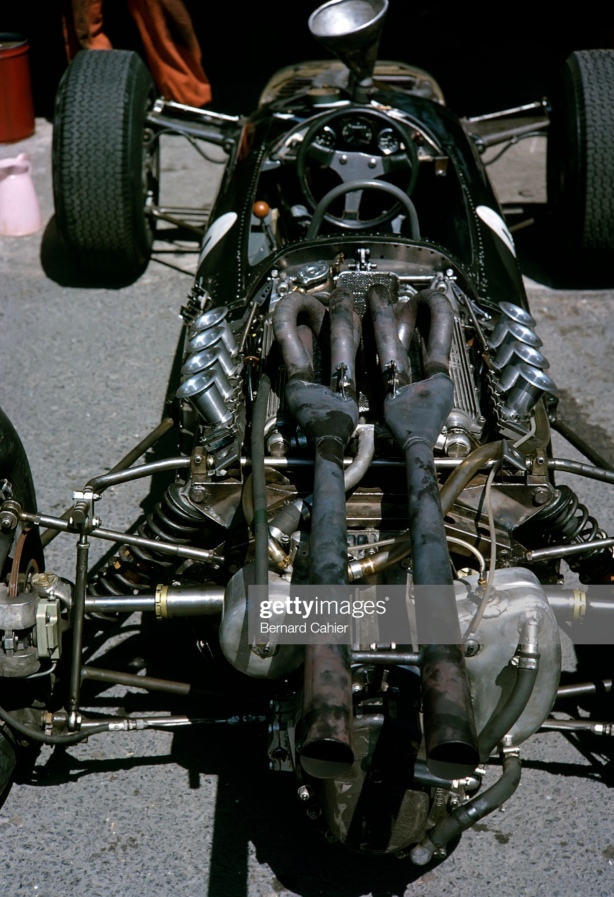
A view is that the only thing between Graham Hill and another world title or so at the time was Jim Clark and the Lotus 25 and Lotus 33- lets make that the only thing between Hill and another title or so was Jim Clark’s God-given other-worldly skills- the gifts that only one driver seems blessed with every decade or so.
The Lotus 25 deserves every accolade accorded it as the first ‘modern monocoque’- the car to which every F1 machine which followed is related. The BRM P61 Mk1 and P61 Mk2 aka ‘P261’ followed the ‘original’ but in almost every respect, other, perhaps than in traction, putting its limited power to the road the BRM was the equal of the 25 and 33- and the BRM ‘P56 Family’ of engines the equal of, if not superior motor however many valves Coventry Climax deployed in its FWMV V8! Tony Rudd, biased as he undoubtedly was, makes this case on pages 232 and 233 of ‘BRM 3’.
Whatever the case, feast your eyes on all of the mechanical gubbins which comprise the whole of a very well rounded package. The car shown is Graham’s F1 P261 during the Mexican GP weekend in 1964- its powered by a P68 1.5 litre V8.
The chassis is an aluminium ‘full monocoque’ made of 18swg ‘half-hard’ duralumin with extension horns supporting engine/gearbox and rear suspension assemblies . Note the period typical inboard front suspension- lower wishbone and rocker actuating a coil spring/damper unit, brakes are solid 9 inch discs outboard- these are light cars remember, brake lines are rubber, we are still a couple of years away from the use of braided steel lines in Europe.
Distinctive BRM steering wheel- who supplied them? Gear lever at left. The engine we have done to death but note the slide Lucas fuel injection, beautiful expressions of the exhaust pipe benders art- you can just see a heat shield beside the radiator cap to keep the hot gasses away from the fuel metering unit which is right behind the roll-over bar.
The rear suspension is again period typical and in contrast to the front is fully ‘outboard’- magnesium uprights, inverted lower wishbone, single top link, twin radius rods to look after fore and aft forces, coil spring/dampers and adjustable roll bars both front and rear. Plumbing for the needs of lubricants is ‘bitsy’ rather than ‘cohesive’ and the lack of shine to the nickel (?) plating doubtless reflects a long hard season- this was the last championship meeting of the year after all. Note the beautifully made splined driveshafts, solid brake rotor and caliper.
I’ve always thought BRM’s gearboxes- i’m not sure if this is a six-speed Type 62 or 72 look a bit butch compared with Mike Hewland’s products of the time but that may not be the case upon having details of said products dimensions and weight. Whilst the boxes’ were the weak link in P261s powered by 1.9 litre V8’s and above that was not the case when 1.5 litre V8s were used which was of course the engine around which the gearboxes were designed at the outset.
Beautifully concepted, designed and built, robust, prodigiously fast cars the performance of which could be accessed by ‘newbees’ and exploited by ‘the gods’ alike.
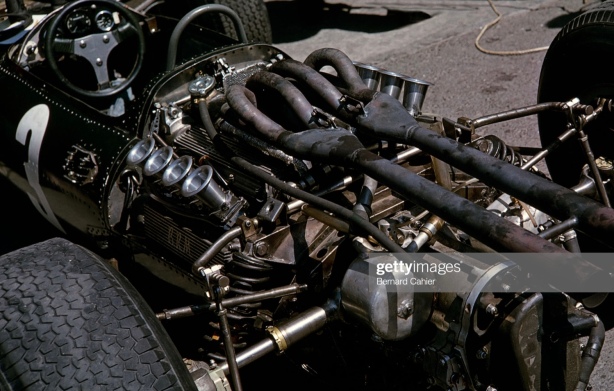
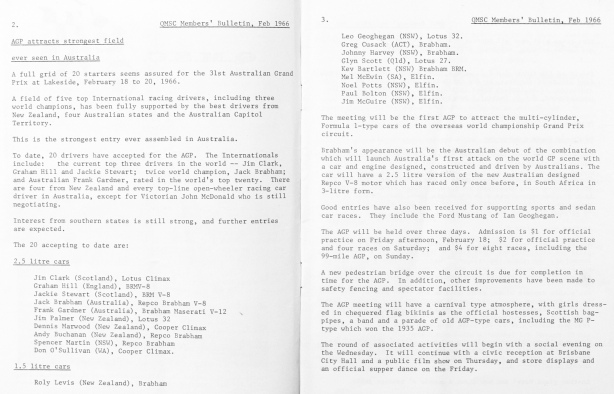
(S Dalton Collection)
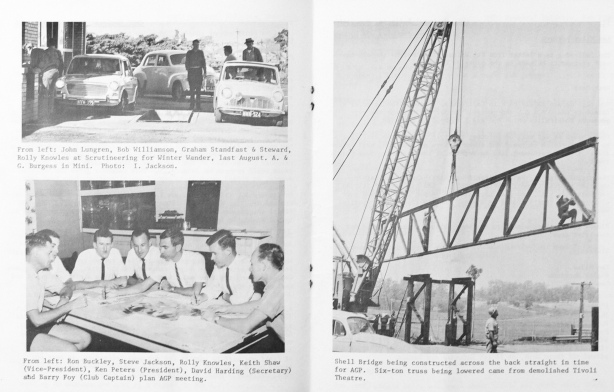
(S Dalton Collection)
Stephen Dalton contributed these pages from the February 1966 Queensland Motor Sports Club newsletter which gives the organisers perspective- note the attention to O,H & S as Stephen points out!
Photo Credits…
Ray Bell, Kevin Drage, ‘Ardmore’, autopics.com, M Bisset Collection, Getty Images- Bernard Cahier, Alvis Upitis, ‘CAN’ Classic Auto News, BRM 3, Dennis Cooper Collection, Brier Thomas via Richard Croston
Bibliography…
‘Australian Motor Racing Annual 1966’, ‘BRM 3’- ‘BRM: The Saga of British Racing Motors Volume 3’ Doug Nye, various articles by Ken Blair in ‘The Canberra Times’ on 8, 15 and 21 February 1966, Bruce Sergent’s race reports on sergent.com, ‘History of The Australian Grand Prix’ Graham Howard and Others, 1966 Tasman Cup review by Allan Brown in oldracingcars.com
Tailpiece: Clark, Lotus 39 Climax, Lakeside 1966…
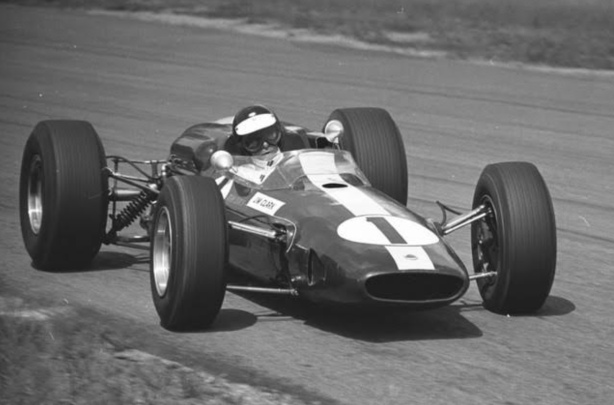
(unattributed)
Jim gulps a big dose of Queensland air as he snicks a Lakeside high-speed apex.
Finito…
